

Concept Papers in Research: Deciphering the blueprint of brilliance
Concept papers hold significant importance as a precursor to a full-fledged research proposal in academia and research. Understanding the nuances and significance of a concept paper is essential for any researcher aiming to lay a strong foundation for their investigation.
Table of Contents
What Is Concept Paper
A concept paper can be defined as a concise document which outlines the fundamental aspects of a grant proposal. It outlines the initial ideas, objectives, and theoretical framework of a proposed research project. It is usually two to three-page long overview of the proposal. However, they differ from both research proposal and original research paper in lacking a detailed plan and methodology for a specific study as in research proposal provides and exclusion of the findings and analysis of a completed research project as in an original research paper. A concept paper primarily focuses on introducing the basic idea, intended research question, and the framework that will guide the research.
Purpose of a Concept Paper
A concept paper serves as an initial document, commonly required by private organizations before a formal proposal submission. It offers a preliminary overview of a project or research’s purpose, method, and implementation. It acts as a roadmap, providing clarity and coherence in research direction. Additionally, it also acts as a tool for receiving informal input. The paper is used for internal decision-making, seeking approval from the board, and securing commitment from partners. It promotes cohesive communication and serves as a professional and respectful tool in collaboration.
These papers aid in focusing on the core objectives, theoretical underpinnings, and potential methodology of the research, enabling researchers to gain initial feedback and refine their ideas before delving into detailed research.
Key Elements of a Concept Paper
Key elements of a concept paper include the title page , background , literature review , problem statement , methodology, timeline, and references. It’s crucial for researchers seeking grants as it helps evaluators assess the relevance and feasibility of the proposed research.
Writing an effective concept paper in academic research involves understanding and incorporating essential elements:
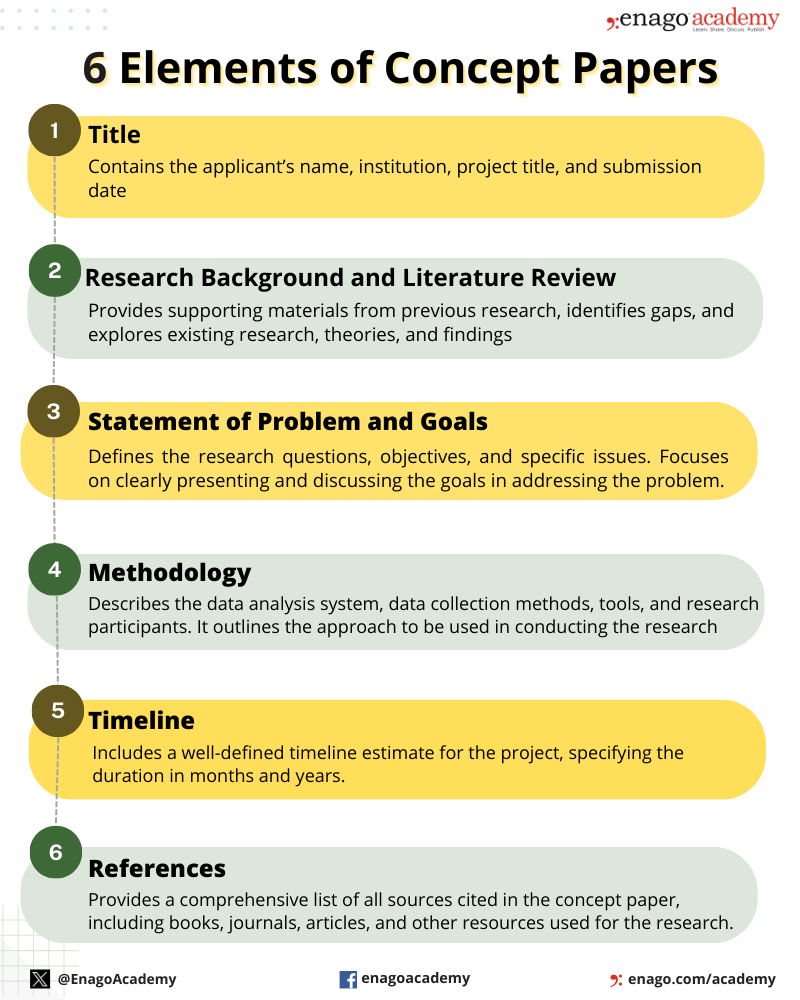
How to Write a Concept Paper?
To ensure an effective concept paper, it’s recommended to select a compelling research topic, pose numerous research questions and incorporate data and numbers to support the project’s rationale. The document must be concise (around five pages) after tailoring the content and following the formatting requirements. Additionally, infographics and scientific illustrations can enhance the document’s impact and engagement with the audience. The steps to write a concept paper are as follows:
1. Write a Crisp Title:
Choose a clear, descriptive title that encapsulates the main idea. The title should express the paper’s content. It should serve as a preview for the reader.
2. Provide a Background Information:
Give a background information about the issue or topic. Define the key terminologies or concepts. Review existing literature to identify the gaps your concept paper aims to fill.
3. Outline Contents in the Introduction:
Introduce the concept paper with a brief overview of the problem or idea you’re addressing. Explain its significance. Identify the specific knowledge gaps your research aims to address and mention any contradictory theories related to your research question.
4. Define a Mission Statement:
The mission statement follows a clear problem statement that defines the problem or concept that need to be addressed. Write a concise mission statement that engages your research purpose and explains why gaining the reader’s approval will benefit your field.
5. Explain the Research Aim and Objectives:
Explain why your research is important and the specific questions you aim to answer through your research. State the specific goals and objectives your concept intends to achieve. Provide a detailed explanation of your concept. What is it, how does it work, and what makes it unique?
6. Detail the Methodology:
Discuss the research methods you plan to use, such as surveys, experiments, case studies, interviews, and observations. Mention any ethical concerns related to your research.
7. Outline Proposed Methods and Potential Impact:
Provide detailed information on how you will conduct your research, including any specialized equipment or collaborations. Discuss the expected results or impacts of implementing the concept. Highlight the potential benefits, whether social, economic, or otherwise.
8. Mention the Feasibility
Discuss the resources necessary for the concept’s execution. Mention the expected duration of the research and specific milestones. Outline a proposed timeline for implementing the concept.
9. Include a Support Section:
Include a section that breaks down the project’s budget, explaining the overall cost and individual expenses to demonstrate how the allocated funds will be used.
10. Provide a Conclusion:
Summarize the key points and restate the importance of the concept. If necessary, include a call to action or next steps.
Although the structure and elements of a concept paper may vary depending on the specific requirements, you can tailor your document based on the guidelines or instructions you’ve been given.
Here are some tips to write a concept paper:
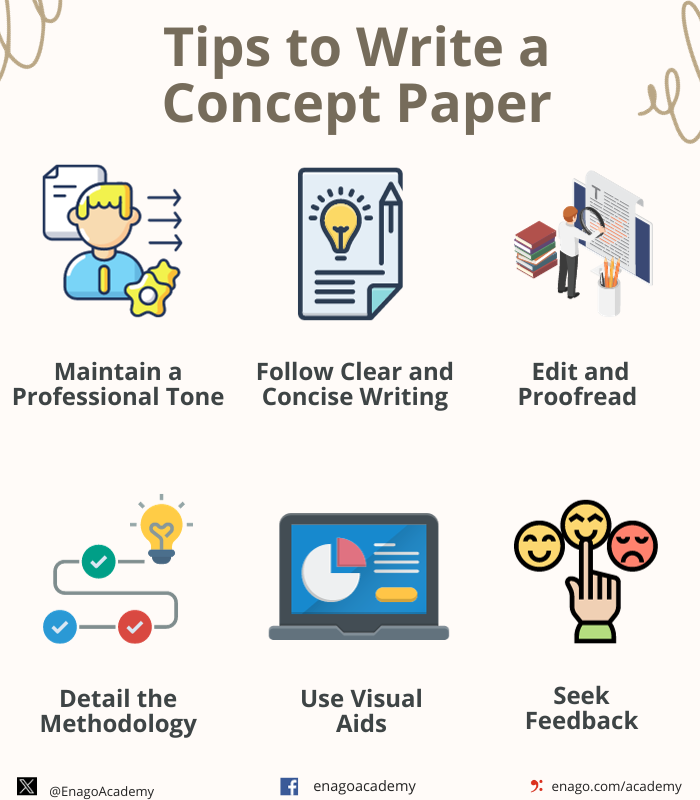
Example of a Concept Paper
Here is an example of a concept paper. Please note, this is a generalized example. Your concept paper should align with the specific requirements, guidelines, and objectives you aim to achieve in your proposal. Tailor it accordingly to the needs and context of the initiative you are proposing.
Download Now!
Importance of a Concept Paper
Concept papers serve various fields, influencing the direction and potential of research in science, social sciences, technology, and more. They contribute to the formulation of groundbreaking studies and novel ideas that can impact societal, economic, and academic spheres.
A concept paper serves several crucial purposes in various fields:
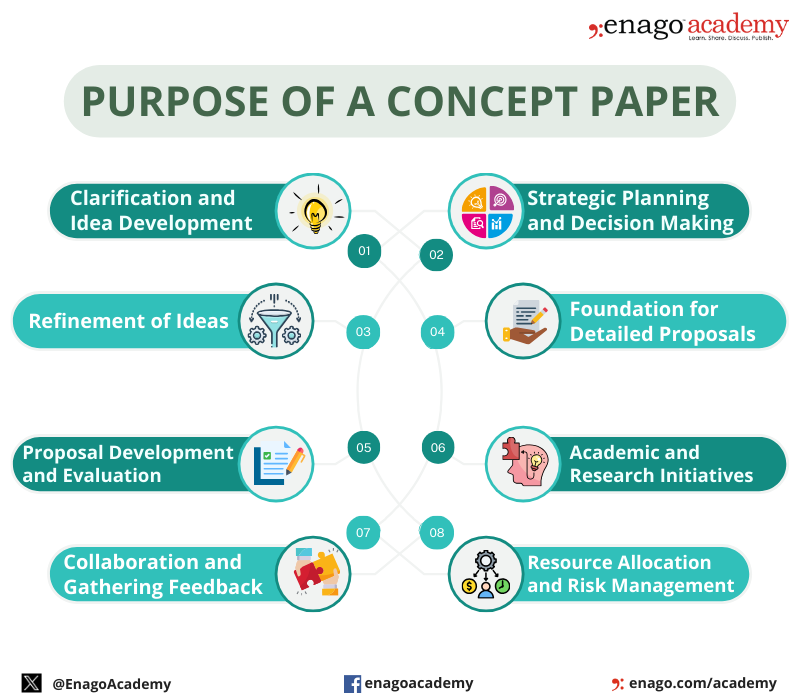
In summary, a well-crafted concept paper is essential in outlining a clear, concise, and structured framework for new ideas or proposals. It helps in assessing the feasibility, viability, and potential impact of the concept before investing significant resources into its implementation.
How well do you understand concept papers? Test your understanding now!
Fill the Details to Check Your Score

Role of AI in Writing Concept Papers
The increasing use of AI, particularly generative models, has facilitated the writing process for concept papers. Responsible use involves leveraging AI to assist in ideation, organization, and language refinement while ensuring that the originality and ethical standards of research are maintained.
AI plays a significant role in aiding the creation and development of concept papers in several ways:
1. Idea Generation and Organization
AI tools can assist in brainstorming initial ideas for concept papers based on key concepts. They can help in organizing information, creating outlines, and structuring the content effectively.
2. Summarizing Research and Data Analysis
AI-powered tools can assist in conducting comprehensive literature reviews, helping writers to gather and synthesize relevant information. AI algorithms can process and analyze vast amounts of data, providing insights and statistics to support the concept presented in the paper.
3. Language and Style Enhancement
AI grammar checker tools can help writers by offering grammar, style, and tone suggestions, ensuring professionalism. It can also facilitate translation, in case a global collaboration.
4. Collaboration and Feedback
AI platforms offer collaborative features that enable multiple authors to work simultaneously on a concept paper, allowing for real-time contributions and edits.
5. Customization and Personalization
AI algorithms can provide personalized recommendations based on the specific requirements or context of the concept paper. They can assist in tailoring the concept paper according to the target audience or specific guidelines.
6. Automation and Efficiency
AI can automate certain tasks, such as citation formatting, bibliography creation, or reference checking, saving time for the writer.
7. Analytics and Prediction
AI models can predict potential outcomes or impacts based on the information provided, helping writers anticipate the possible consequences of the proposed concept.
8. Real-Time Assistance
AI-driven chat-bots can provide real-time support and answers to specific questions related to the concept paper writing process.
AI’s role in writing concept papers significantly streamlines the writing process, enhances the quality of the content, and provides valuable assistance in various stages of development, contributing to the overall effectiveness of the final document.
Concept papers serve as the stepping stone in the research journey, aiding in the crystallization of ideas and the formulation of robust research proposals. It the cornerstone for translating ideas into impactful realities. Their significance spans diverse domains, from academia to business, enabling stakeholders to evaluate, invest, and realize the potential of groundbreaking concepts.
Frequently Asked Questions
A concept paper can be defined as a concise document outlining the fundamental aspects of a grant proposal such as the initial ideas, objectives, and theoretical framework of a proposed research project.
A good concept paper should offer a clear and comprehensive overview of the proposed research. It should demonstrate a strong understanding of the subject matter and outline a structured plan for its execution.
Concept paper is important to develop and clarify ideas, develop and evaluate proposal, inviting collaboration and collecting feedback, presenting proposals for academic and research initiatives and allocating resources.
I got wonderful idea
It helps a lot for my concept paper.
Rate this article Cancel Reply
Your email address will not be published.

Enago Academy's Most Popular Articles

- Career Corner
- Trending Now
Recognizing the signs: A guide to overcoming academic burnout
As the sun set over the campus, casting long shadows through the library windows, Alex…

- Diversity and Inclusion
Reassessing the Lab Environment to Create an Equitable and Inclusive Space
The pursuit of scientific discovery has long been fueled by diverse minds and perspectives. Yet…

- AI in Academia
Simplifying the Literature Review Journey — A comparative analysis of 6 AI summarization tools
Imagine having to skim through and read mountains of research papers and books, only to…

- Reporting Research
How to Improve Lab Report Writing: Best practices to follow with and without AI-assistance
Imagine you’re a scientist who just made a ground-breaking discovery! You want to share your…

Achieving Research Excellence: Checklist for good research practices
Academia is built on the foundation of trustworthy and high-quality research, supported by the pillars…

Sign-up to read more
Subscribe for free to get unrestricted access to all our resources on research writing and academic publishing including:
- 2000+ blog articles
- 50+ Webinars
- 10+ Expert podcasts
- 50+ Infographics
- 10+ Checklists
- Research Guides
We hate spam too. We promise to protect your privacy and never spam you.
I am looking for Editing/ Proofreading services for my manuscript Tentative date of next journal submission:

What should universities' stance be on AI tools in research and academic writing?

Community Blog
Keep up-to-date on postgraduate related issues with our quick reads written by students, postdocs, professors and industry leaders.
What is a Concept Paper and How do You Write One?
- By DiscoverPhDs
- August 26, 2020

What is a Concept Paper?
A concept paper is a short document written by a researcher before starting their research project, with the purpose of explaining what the study is about, why it is important and the methods that will be used.
The concept paper will include your proposed research title, a brief introduction to the subject, the aim of the study, the research questions you intend to answer, the type of data you will collect and how you will collect it. A concept paper can also be referred to as a research proposal.
What is the Purpose of a Concept Paper?
The primary aim of a research concept paper is to convince the reader that the proposed research project is worth doing. This means that the reader should first agree that the research study is novel and interesting. They should be convinced that there is a need for this research and that the research aims and questions are appropriate.
Finally, they should be satisfied that the methods for data collection proposed are feasible, are likely to work and can be performed within the specific time period allocated for this project.
The three main scenarios in which you may need to write a concept paper are if you are:
- A final year undergraduate or master’s student preparing to start a research project with a supervisor.
- A student submitting a research proposal to pursue a PhD project under the supervision of a professor.
- A principal investigator submitting a proposal to a funding body to secure financial support for a research project.
How Long is a Concept Paper?
The concept paper format is usually between 2 and 3 pages in length for students writing proposals for undergraduate, master’s or PhD projects. Concept papers written as part of funding applications may be over 20 pages in length.
How do you Write a Concept Paper?
There are 6 important aspects to consider when writing a concept paper or research proposal:
- 1. The wording of the title page, which is best presented as a question for this type of document. At this study concept stage, you can write the title a bit catchier, for example “Are 3D Printed Engine Parts Safe for Use in Aircraft?”.
- A brief introduction and review of relevant existing literature published within the subject area and identification of where the gaps in knowledge are. This last bit is particularly important as it guides you in defining the statement of the problem. The concept paper should provide a succinct summary of ‘the problem’, which is usually related to what is unknown or poorly understood about your research topic . By the end of the concept paper, the reader should be clear on how your research idea will provide a ‘solution’ to this problem.
- The overarching research aim of your proposed study and the objectives and/or questions you will address to achieve this aim. Align all of these with the problem statement; i.e. write each research question as a clear response to addressing the limitations and gaps identified from previous literature. Also give a clear description of your primary hypothesis.
- The specific data outputs that you plan to capture. For example, will this be qualitative or quantitative data? Do you plan to capture data at specific time points or at other defined intervals? Do you need to repeat data capture to asses any repeatability and reproducibility questions?
- The research methodology you will use to capture this data, including any specific measurement or analysis equipment and software you will use, and a consideration of statistical tests to help interpret the data. If your research requires the use of questionnaires, how will these be prepared and validated? In what sort of time frame would you plan to collect this data?
- Finally, include a statement of the significance of the study , explaining why your research is important and impactful. This can be in the form of a concluding paragraph that reiterate the statement of the problem, clarifies how your research will address this and explains who will benefit from your research and how.
You may need to include a short summary of the timeline for completing the research project. Defining milestones of the time points at which you intend to complete certain tasks can help to show that you’ve considered the practicalities of running this study. It also shows that what you have proposed is feasible in order to achieve your research goal.
If you’re pitching your proposed project to a funder, they may allocate a proportion of the money based on the satisfactory outcome of each milestone. These stakeholders may also be motivated by knowing that you intend to convert your dissertation into an article for journal publication; this level of dissemination is of high importance to them.
Additionally, you may be asked to provide a brief summary of the projected costs of running the study. For a PhD project this could be the bench fees associated with consumables and the cost of any travel if required.
Make sure to include references and cite all other literature and previous research that you discuss in your concept paper.
This guide gave you an overview of the key elements you need to know about when writing concept papers. The purpose of these are first to convey to the reader what your project’s purpose is and why your research topic is important; this is based on the development of a problem statement using evidence from your literature review.
Explain how it may positively impact your research field and if your proposed research design is appropriate and your planned research method achievable.

In this post you’ll learn what the significance of the study means, why it’s important, where and how to write one in your paper or thesis with an example.

You’ve impressed the supervisor with your PhD application, now it’s time to ace your interview with these powerful body language tips.

Learn 10 ways to impress a PhD supervisor for increasing your chances of securing a project, developing a great working relationship and more.
Join thousands of other students and stay up to date with the latest PhD programmes, funding opportunities and advice.

Browse PhDs Now

The scope and delimitations of a thesis, dissertation or paper define the topic and boundaries of a research problem – learn how to form them.

Self-plagiarism is when you try and pass off work that you’ve previously done as something that is completely new.

Islam is in the final year of his Physics PhD program at Washington State University in the field of particle cosmology. His research is on the Possible Connections Between Inflaton and Dark Energy Within An Oscillating Reheating Framework.

Frances recently completed her PhD at the University of Bristol. Her research investigated the causes and consequences of hazardous lava-water interactions.
Join Thousands of Students

How to write a concept paper effectively
Planning to Write
Sunaina Singh

What is a concept paper?
Simply put, a concept paper is a preliminary document that sets out to explain what a proposed study is about, why it is being undertaken, and how it will be carried out. It scrutinizes a concept or idea and provides an overview of the project a researcher wants to embark on.
A researcher might need to write a concept paper to obtain permission to undertake the research project or to seek financial support for it. This means that a well-framed and compelling concept paper has high chances of convincing the target reader that the proposed research project is worth carrying out. In other words, an impressive concept paper might help a researcher secure the approvals or grants they are looking for.

Why write a concept paper?
Concept papers are typically prepared by entrepreneurs working on a business proposal or product, or by students and researchers in academia. Such documents are aimed at securing feedback on a research idea and seeking potential investors or funders. In fact, such a document might even help determine whether a project idea is feasible in the first place.
In academia, a concept paper might be needed before an undergraduate, master’s, or doctoral candidate commences work on a research project with a supervisor. Even advanced career researchers or principal investigators might need to draft a concept paper when submitting a project proposal to a funding body to obtain the necessary grants.
Listed below are some reasons why concept papers are important.
1. To explore and expand an idea: Researchers can use concept papers to transform an incipient research idea into a focused, high-quality study proposal. The paper is also a means to obtain feedback that can be used to strengthen a detailed proposal at a later stage.
2. To draw the interest of funding agencies : Through an effective concept paper, an investigator can justify why their project is worthy of funding. If the project is within the mission of the funding body and has potential to advance the field, the investigator has a high chance of success in obtaining the required grants.
3. To identify potential flaws or gaps beforehand: Putting in time and effort in writing a concept paper will help develop a focused description of the project and will allow the researcher to examine the problem from all angles. At early stages, experts or funders might spot potential gaps and weaknesses in the proposed project. Accordingly, the researcher can identify solutions and improve the proposal (e.g., in terms of the goals or methodology).
4. To serve as the foundation of the full proposal: A concept paper is preliminary, as it precedes a full proposal. Funding agencies often ask for concept papers before the full proposal submission. This helps assess whether the identified experimental methods are appropriate and can be performed within the specific timeframe drawn up for the project.
5. To help a researcher stick to project timelines: A concept paper defines a timeline, which helps the investigator to keep the project on track, manage time effectively, and reach the targeted milestones successfully.
How should a concept paper be structured?
A concept paper could be within 5 pages for proposals for master’s or PhD projects. Concept papers written as part of funding applications might even be up to 20 pages long. The format and flow of the paper would depend on the type of project and expected outcome.
Funding bodies requesting concept papers might provide a template or format, which should be adhered to. However, if templates or formats are not specified, a concept paper may be structured according to the chief elements described below.
1. An impactful title: The title should be sufficiently informative and leave a lasting impression. It should reflect the purpose and significance of the study. The title should not be too long (ideally within 15 words). The title could even be in the form of a question.
2. A clear mission statement: In a few sentences, the study objective(s) or research question should be stated. Given that the main objective of a concept paper is to convince the reader that the proposed project is worth executing, it must convey the novelty and research rationale in a convincing manner.
3. A brief yet effective overview: A concept paper should present a survey of the problem, supported by a preliminary literature review of the research topic. However, the review need not be too detailed. The paper should provide a summary of what is already known about the topic and an explanation of what knowledge gaps the research is expected to fill. Any contradictory theories may also be indicated.
4. An outline of the proposed methods: The methods that the researcher plans to use to answer the research question should be described. This section would cover ethical issues (if applicable), experimental materials and methods, the type of data to be collected, and the methods by which the data will be collected and analyzed. The estimated time to achieve different research goals should also be indicated.
5. A statement of the expected implications : A concept paper would be incomplete without a concise section on short-term and long-term impacts of the research, potential applications, impact on society and policies, and any other future visions. Know how to write a statement of the problem in a step-by-step way.
What are the key points to remember when drafting a concept paper?
1. Keep the reader in mind: If the concept paper targets experts in the field or potential collaborators/partners, it should be tailored accordingly, e.g., it can contain technical language. If the audience comprises potential sponsors/funders, the concept paper should be streamlined, keeping in mind their priorities and requirements. Such a version should contain minimal jargon and be easily digestible by non-specialists.
Bonus takeaway exclusively for community members
2. Note that a concept paper is not a journal article: Concept papers differ from journal articles in that the primary aim of a concept paper is to convince a sponsor of the feasibility and significance of a project. In that sense, it is akin to a sales pitch! It should highlight the project’s purpose and impact. To strengthen one’s case, previously awarded grants or published papers may also be indicated.
3. Make a good impression: While a concept paper should be cogent and compelling, it goes without saying that the document should be well-written and well-formatted, as well as free of grammatical, spelling, or punctuation errors. Clarity, consistency, and conciseness are key. In the absence of a formatting template, basic formatting should be in place, e.g., uniform font, adequate line spacing, and appropriate margins. Under Editage’s Scientific Editing Service , a researcher can have a concept paper assessed by a subject matter expert for an in-depth critique on the content and further checked and corrected by editors for language and readability.
Are you brimming with ideas for a research project? Now that you know the main elements that might give your proposal an edge over others, maybe you are ready to set a project in motion by starting with a concept paper.
Related reading:
- 5 Practical tips for writing your first scientific paper [Download publication schedule planner]
- The basics of writing a statement of the problem for your research proposal
- What reviewers look for in a grant proposal
Create a free account and access this bonus resource

Get Instant Access

for this article
Published on: Jul 15, 2021
- Research Planning
- Research Funding
You're looking to give wings to your academic career and publication journey. We like that!
Why don't we give you complete access! Create a free account and get unlimited access to all resources & a vibrant researcher community.
One click sign-in with your social accounts

Sign up via email
1536 visitors saw this today and 1210 signed up.
Subscribe to Conducting Research
Confirm that you would also like to sign up for free personalized email coaching for this stage.
Related Reading

A young researcher's guide to a systematic review

The basics of converting your PhD thesis into journal articles

A young researcher's guide to writing a clinical case report
How to write a concept paper effectively 7 min read
Conquering plagiarism in nursing research and authorship 10 min read
"Brazilian researchers need not despair" 8 min read
What is a lay summary? 8 min read
How to collaborate effectively and ensure your research gets the attention it deserves 16 min read
Trending Searches
- Statement of the problem
- Background of study
- Scope of the study
- Types of qualitative research
- Rationale of the study
- Concept paper
- Literature review
- Introduction in research
- Under "Editor Evaluation"
- Ethics in research
Recent Searches
- Review paper
- Responding to reviewer comments
- Predatory publishers
- Scope and delimitations
- Open access
- Plagiarism in research
- Journal selection tips
- Editor assigned
- Types of articles
- "Reject and Resubmit" status
- Decision in process
- Conflict of interest
Conceptual review papers: revisiting existing research to develop and refine theory
- Theory/Conceptual
- Published: 29 April 2020
- Volume 10 , pages 27–35, ( 2020 )
Cite this article
- John Hulland 1
5691 Accesses
56 Citations
8 Altmetric
Explore all metrics
Conceptual review papers can theoretically enrich the field of marketing by reviewing extant knowledge, noting tensions and inconsistencies, identifying important gaps as well as key insights, and proposing agendas for future research. The result of this process is a theoretical contribution that refines, reconceptualizes, or even replaces existing ways of viewing a phenomenon. This paper spells out the primary aims of conceptual reviews and clarifies how they differ from other theory development efforts. It also describes elements essential to a strong conceptual review paper and offers a specific set of best practices that can be used to distinguish a strong conceptual review from a weak one.
This is a preview of subscription content, log in via an institution to check access.
Access this article
Price includes VAT (Russian Federation)
Instant access to the full article PDF.
Rent this article via DeepDyve
Institutional subscriptions
Similar content being viewed by others
Meta-analysis: integrating accumulated knowledge.
Dhruv Grewal, Nancy Puccinelli & Kent B. Monroe

Designing conceptual articles: four approaches
Elina Jaakkola
Contours of the marketing literature: Text, context, point-of-view, research horizons, interpretation, and influence in marketing
Terry Clark, Thomas Martin Key & Carol Azab
Palmatier et al. ( 2018 ) reference a study of the frequency with which review papers were published in top marketing journals during the 2012–2016 period. Focusing on the top six journals included in the Financial Times (( FT-50 ) journal list, the study found that “ JAMS has become the most common outlet … publishing 31% of all review papers that appeared in the top six marketing journals.”
The bifurcation here between theory development “from scratch” versus through conceptual review is potentially somewhat misleading, since the latter can also result in novel theoretical insights. Furthermore, many conceptual papers make significant theoretical contributions by building on existing theory without themselves being review papers. Nonetheless, conceptual reviews necessarily involve working with extant, published work.
This focus is quite distinct from the approach proposed by Zeithaml et al. ( 2020 ). Their emphasis is on “an approach that is ideally suited to the development of theories in marketing: the ‘theories-in-use’ (TIU) approach” (p. 32). They propose it as an alternative inductive methodology (vs. case studies and ethnographies) to developing grounded theory.
These elements are drawn from Hulland & Houston ( 2020 ), MacInnis ( 2011 ), Palmatier et al. ( 2018 ), and Yadav ( 2010 ). Houston ( 2020 ), MacInnis ( 2011 ), Palmatier, Houston & Hulland et al. ( 2018 ), and Yadav ( 2010 ).
These underlying assumptions are a crucial component in developing strong arguments for theory development (Toulmin 1958 ).
MacInnis ( 2011 ) describes eight critical skills for conceptual thinking that are arrayed across four dimensions: envisioning (identifying vs. revising), explicating (delineating vs. summarizing), relating (differentiating vs. integrating, and debating (advocating vs. refuting). For conceptual review papers, summarizing and revising represent critical skills that need to be harnessed by the author (whereas identifying and delineating are skills more critical to uncovering new ideas). For the other two dimensions (relating and debating), a more balanced use of the associated skills is needed (i.e., both differentiating and integrating are important, and both advocating and refuting are important).
In her paper, Jaakkola ( 2020 ) describes four different types of research designs for conceptual reviews: (1) theory synthesis, (2) theory adaptation, (3) typology, and (4) model. In the current paper, elements from all four of these types are discussed.
In doing so, Khamitov et al. discover seven overarching insights that reveal gaps in the interfaces between the three streams. This highlighting of gaps represents stage four in the theory refinement process.
Not all of the gaps in a specific domain are necessarily valuable, however. Just because no one has studied a phenomenon in a particular industry or region, or with a particular method does not mean that a filling of that gap is required (or even valued).
Antonakis, J., Bartardox, N., Liu, Y., & Schriesheim, C. A. (2014). What makes articles highly cited? The Leadership Quarterly, 25 (1), 152–179.
Article Google Scholar
Barczak, G. (2017). From the editor: Writing a review article. Journal of Product Innovation Management, 34 (2), 120–121.
Bem, D.J. (1995). Writing a review article for Psychological Bulletin . Psychological Bulletin , 118(2), 172–177.
Bettencourt, L. A., & Houston, M. B. (2001). Assessing the impact of article method type and subject area on citation frequency and reference diversity. Marketing Letters, 12 (4), 327–340.
Dekimpe, M. G., & Deleersnyder, B. (2018). Business cycle research in marketing: A review and research agenda. Journal of the Academy of Marketing Science, 46 (1), 31–58.
Dowling, K., Guhl, D., Klapper, D., Spann, M., Stich, L., & Yegoryan, N. (2020). Behavioral biases in marketing. Journal of the Academy of Marketing Science in press , 48 (3), 449–477.
Gilson, L. L., & Goldberg, C. B. (2015). Editors’ comment: So, what is a conceptual paper? Group & Organization Management, 40 (2), 127–130.
Grewal, D., Puccinelli, N. M., & Monroe, K. B. (2018). Meta-analysis: Integrating accumulated knowledge. Journal of the Academy of Marketing Science, 46 (1), 9–30.
Houston, M. B. (2019). Four facets of rigor. Journal of the Academy of Marketing Science, 47 (4), 570–573.
Hulland, J., & Houston, M. B. (2020). Why systematic review papers and meta-analyses matter: An introduction to the special issue on generalizations in marketing. Journal of the Academy of Marketing Science, 48 (3) in press, 351–359.
Hulland, J., Baumgartner, H., & Smith, K. M. (2018). Marketing survey research best practices: Evidence and recommendations from a review of JAMS articles. Journal of the Academy of Marketing Science, 46 (1), 92–108.
Jaakkola, E. (2020). Designing conceptual articles: Four approaches. Journal of the Academy of Marketing Science in press.
Khamitov, M., Gregoire, Y., & Suri, A. (2020). A systematic review of brand transgression, service failure recovery and product-harm crisis: Integration and guiding insights. Journal of the Academy of Marketing Science in press , 48 (3), 519–542.
Kozlenkova, I. V., Samaha, S. A., & Palmatier, R. W. (2014). Resource-based theory in marketing. Journal of the Academy of Marketing Science, 42 (1), 1–21.
Lamberton, C., & Stephen, A. T. (2016). A thematic exploration of digital, social media, and mobile marketing: Research evolution from 2000 to 2015 and an agenda for future inquiry. Journal of Marketing, 80 (November), 146–172.
Littell, J. H., Corcoran, J., & Pillai, V. (2008). Systematic reviews and meta-analysis . New York: Oxford University Press.
MacInnis, D. J. (2011). A framework for conceptual contributions in marketing. Journal of Marketing, 75 (July), 136–154.
Palmatier, R. W. (2016). Improving publishing success at JAMS : Contribution and positioning. Journal of the Academy of Marketing Science, 44 (6), 655–659.
Palmatier, R. W., Houston, M. B., & Hulland, J. (2018). Review articles: Purpose, process, and structure. Journal of the Academy of Marketing Science, 46 (1), 1–5.
Rindfleisch, A., & Heide, J. B. (1997). Transaction cost analysis: Past, present, and future applications. Journal of Marketing, 61 (4), 30–54.
Rosario, A. B., de Valck, K., & Sotgiu, F. (2020). Conceptualizing the electronic word-of-mouth process: What we know and need to know about eWOM creation, exposure, and evaluation. Journal of the Academy of Marketing Science in press.
Samiee, S. (1994). Customer evaluation of products in a global market. Journal of International Business Studies, 25 (3), 579–604.
Sample, K. L., Hagtvedt, H., & Brasel, S. A. (2020). Components of visual perception in marketing contexts: A conceptual framework and review. Journal of the Academy of Marketing Science in press , 48 (3), 405–421.
Short, J. (2009). The art of writing a review article. Journal of Management, 35 (6), 1312–1317.
Sorescu, A., Warren, N. L., & Ertekin, L. (2017). Event study methodology in the marketing literature: An overview. Journal of the Academy of Marketing Science, 45 (2), 186–207.
Steinhoff, L., Arli, D., Weaven, S., & Kozlenkova, I. V. (2019). Online relationship marketing. Journal of the Academy of Marketing Science, 47 (3), 369–393.
Stewart, D. W., & Zinkhan, G. M. (2006). Enhancing marketing theory in academic research. Journal of the Academy of Marketing Science, 34 (Fall), 477–480.
Sutton, R. I., & Staw, B. M. (1995). What theory is not . Administrative Science Quarterly, 40 (3), 371–384.
Toulmin, S. (1958). The uses of argument . Cambridge, U.K.: Cambridge University Press.
Google Scholar
Wade, M., & Hulland, J. (2004). The resource-based view and information systems research: Review, extension, and suggestions for future research. MIS Quarterly, 28 (1), 107–142.
Yadav, M. S. (2010). The decline of conceptual articles and implications for knowledge development. Journal of Marketing, 74 (January), 1–19.
Zeithaml, V. A., Jaworski, B. J., Kohli, A. K., Tuli, K. R., Ulaga, W., & Zaltman, G. (2020). A theories-in-use approach to building marketing theory. Journal of Marketing, 84 (1), 32–51.
Download references
Author information
Authors and affiliations.
Terry College of Business, University of Georgia, Athens, GA, 30602, USA
John Hulland
You can also search for this author in PubMed Google Scholar
Corresponding author
Correspondence to John Hulland .
Additional information
Publisher’s note.
Springer Nature remains neutral with regard to jurisdictional claims in published maps and institutional affiliations.
Rights and permissions
Reprints and permissions
About this article
Hulland, J. Conceptual review papers: revisiting existing research to develop and refine theory. AMS Rev 10 , 27–35 (2020). https://doi.org/10.1007/s13162-020-00168-7
Download citation
Received : 11 March 2020
Accepted : 01 April 2020
Published : 29 April 2020
Issue Date : June 2020
DOI : https://doi.org/10.1007/s13162-020-00168-7
Share this article
Anyone you share the following link with will be able to read this content:
Sorry, a shareable link is not currently available for this article.
Provided by the Springer Nature SharedIt content-sharing initiative
- Conceptual review papers
- Marketing theory
- Find a journal
- Publish with us
- Track your research
Have a language expert improve your writing
Run a free plagiarism check in 10 minutes, generate accurate citations for free.
- Knowledge Base
- Methodology
- What Is a Conceptual Framework? | Tips & Examples
What Is a Conceptual Framework? | Tips & Examples
Published on August 2, 2022 by Bas Swaen and Tegan George. Revised on March 18, 2024.

A conceptual framework illustrates the expected relationship between your variables. It defines the relevant objectives for your research process and maps out how they come together to draw coherent conclusions.
Keep reading for a step-by-step guide to help you construct your own conceptual framework.
Table of contents
Developing a conceptual framework in research, step 1: choose your research question, step 2: select your independent and dependent variables, step 3: visualize your cause-and-effect relationship, step 4: identify other influencing variables, frequently asked questions about conceptual models.
A conceptual framework is a representation of the relationship you expect to see between your variables, or the characteristics or properties that you want to study.
Conceptual frameworks can be written or visual and are generally developed based on a literature review of existing studies about your topic.
Your research question guides your work by determining exactly what you want to find out, giving your research process a clear focus.
However, before you start collecting your data, consider constructing a conceptual framework. This will help you map out which variables you will measure and how you expect them to relate to one another.
In order to move forward with your research question and test a cause-and-effect relationship, you must first identify at least two key variables: your independent and dependent variables .
- The expected cause, “hours of study,” is the independent variable (the predictor, or explanatory variable)
- The expected effect, “exam score,” is the dependent variable (the response, or outcome variable).
Note that causal relationships often involve several independent variables that affect the dependent variable. For the purpose of this example, we’ll work with just one independent variable (“hours of study”).
Now that you’ve figured out your research question and variables, the first step in designing your conceptual framework is visualizing your expected cause-and-effect relationship.
We demonstrate this using basic design components of boxes and arrows. Here, each variable appears in a box. To indicate a causal relationship, each arrow should start from the independent variable (the cause) and point to the dependent variable (the effect).

It’s crucial to identify other variables that can influence the relationship between your independent and dependent variables early in your research process.
Some common variables to include are moderating, mediating, and control variables.
Moderating variables
Moderating variable (or moderators) alter the effect that an independent variable has on a dependent variable. In other words, moderators change the “effect” component of the cause-and-effect relationship.
Let’s add the moderator “IQ.” Here, a student’s IQ level can change the effect that the variable “hours of study” has on the exam score. The higher the IQ, the fewer hours of study are needed to do well on the exam.

Let’s take a look at how this might work. The graph below shows how the number of hours spent studying affects exam score. As expected, the more hours you study, the better your results. Here, a student who studies for 20 hours will get a perfect score.

But the graph looks different when we add our “IQ” moderator of 120. A student with this IQ will achieve a perfect score after just 15 hours of study.

Below, the value of the “IQ” moderator has been increased to 150. A student with this IQ will only need to invest five hours of study in order to get a perfect score.

Here, we see that a moderating variable does indeed change the cause-and-effect relationship between two variables.
Mediating variables
Now we’ll expand the framework by adding a mediating variable . Mediating variables link the independent and dependent variables, allowing the relationship between them to be better explained.
Here’s how the conceptual framework might look if a mediator variable were involved:

In this case, the mediator helps explain why studying more hours leads to a higher exam score. The more hours a student studies, the more practice problems they will complete; the more practice problems completed, the higher the student’s exam score will be.
Moderator vs. mediator
It’s important not to confuse moderating and mediating variables. To remember the difference, you can think of them in relation to the independent variable:
- A moderating variable is not affected by the independent variable, even though it affects the dependent variable. For example, no matter how many hours you study (the independent variable), your IQ will not get higher.
- A mediating variable is affected by the independent variable. In turn, it also affects the dependent variable. Therefore, it links the two variables and helps explain the relationship between them.
Control variables
Lastly, control variables must also be taken into account. These are variables that are held constant so that they don’t interfere with the results. Even though you aren’t interested in measuring them for your study, it’s crucial to be aware of as many of them as you can be.

A mediator variable explains the process through which two variables are related, while a moderator variable affects the strength and direction of that relationship.
A confounding variable is closely related to both the independent and dependent variables in a study. An independent variable represents the supposed cause , while the dependent variable is the supposed effect . A confounding variable is a third variable that influences both the independent and dependent variables.
Failing to account for confounding variables can cause you to wrongly estimate the relationship between your independent and dependent variables.
Yes, but including more than one of either type requires multiple research questions .
For example, if you are interested in the effect of a diet on health, you can use multiple measures of health: blood sugar, blood pressure, weight, pulse, and many more. Each of these is its own dependent variable with its own research question.
You could also choose to look at the effect of exercise levels as well as diet, or even the additional effect of the two combined. Each of these is a separate independent variable .
To ensure the internal validity of an experiment , you should only change one independent variable at a time.
A control variable is any variable that’s held constant in a research study. It’s not a variable of interest in the study, but it’s controlled because it could influence the outcomes.
A confounding variable , also called a confounder or confounding factor, is a third variable in a study examining a potential cause-and-effect relationship.
A confounding variable is related to both the supposed cause and the supposed effect of the study. It can be difficult to separate the true effect of the independent variable from the effect of the confounding variable.
In your research design , it’s important to identify potential confounding variables and plan how you will reduce their impact.
Cite this Scribbr article
If you want to cite this source, you can copy and paste the citation or click the “Cite this Scribbr article” button to automatically add the citation to our free Citation Generator.
Swaen, B. & George, T. (2024, March 18). What Is a Conceptual Framework? | Tips & Examples. Scribbr. Retrieved April 9, 2024, from https://www.scribbr.com/methodology/conceptual-framework/
Is this article helpful?
Other students also liked
Independent vs. dependent variables | definition & examples, mediator vs. moderator variables | differences & examples, control variables | what are they & why do they matter, "i thought ai proofreading was useless but..".
I've been using Scribbr for years now and I know it's a service that won't disappoint. It does a good job spotting mistakes”
- Skip to main content
- Skip to primary sidebar
- Skip to footer
- QuestionPro

- Solutions Industries Gaming Automotive Sports and events Education Government Travel & Hospitality Financial Services Healthcare Cannabis Technology Use Case NPS+ Communities Audience Contactless surveys Mobile LivePolls Member Experience GDPR Positive People Science 360 Feedback Surveys
- Resources Blog eBooks Survey Templates Case Studies Training Help center
Home Market Research
Conceptual Research: Definition, Framework, Example and Advantages
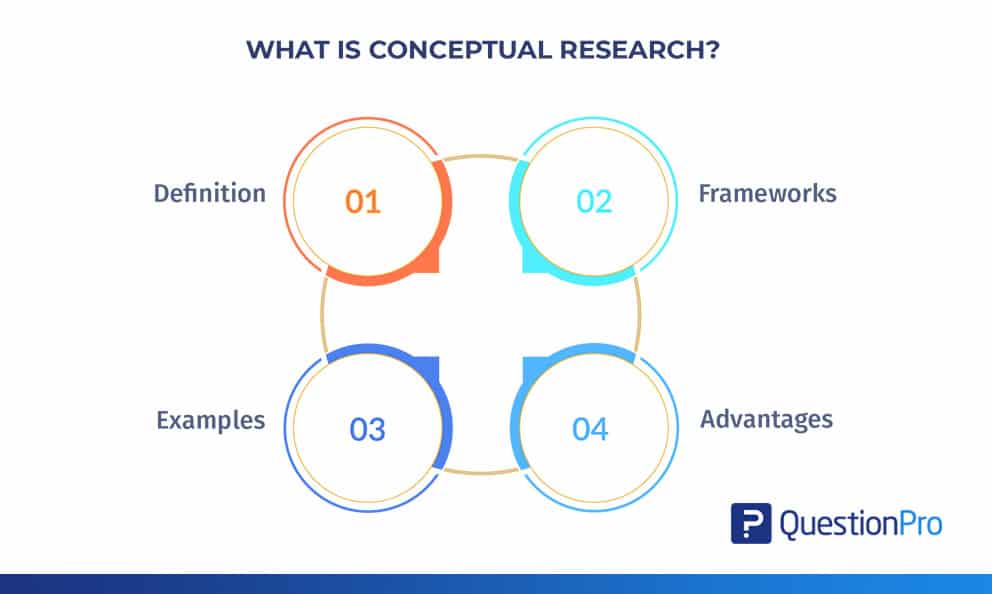
Conceptual Research: Definition
Conceptual research is defined as a methodology wherein research is conducted by observing and analyzing already present information on a given topic. Conceptual research doesn’t involve conducting any practical experiments. It is related to abstract concepts or ideas. Philosophers have long used conceptual research to develop new theories or interpret existing theories in a different light.
For example, Copernicus used conceptual research to come up with the concepts of stellar constellations based on his observations of the universe. Down the line, Galileo simplified Copernicus’s research by making his own conceptual observations which gave rise to more experimental research and confirmed the predictions made at that time.
The most famous example of conceptual research is Sir Issac Newton. He observed his surroundings to conceptualize and develop theories about gravitation and motion.
Einstein is widely known and appreciated for his work on conceptual research. Although his theories were based on conceptual observations, Einstein also proposed experiments to come up with theories to test the conceptual research.
Nowadays, conceptual research is used to answer business questions and solve real-world problems. Researchers use analytical research tools called conceptual frameworks to make conceptual distinctions and organize ideas required for research purposes.
Conceptual Research Framework
Conceptual research framework constitutes of a researcher’s combination of previous research and associated work and explains the occurring phenomenon. It systematically explains the actions needed in the course of the research study based on the knowledge obtained from other ongoing research and other researchers’ points of view on the subject matter.
Here is a stepwise guide on how to create the conceptual research framework:
01. Choose the topic for research
Before you start working on collecting any research material, you should have decided on your topic for research. It is important that the topic is selected beforehand and should be within your field of specialization.
02. Collect relevant literature
Once you have narrowed down a topic, it is time to collect relevant information about it. This is an important step, and much of your research is dependent on this particular step, as conceptual research is mostly based on information obtained from previous research. Here collecting relevant literature and information is the key to successfully completing research.
The material that you should preferably use is scientific journals , research papers published by well-known scientists , and similar material. There is a lot of information available on the internet and in public libraries as well. All the information that you find on the internet may not be relevant or true. So before you use the information, make sure you verify it.

03. Identify specific variables
Identify the specific variables that are related to the research study you want to conduct. These variables can give your research a new scope and can also help you identify how these can be related to your research design . For example, consider hypothetically you want to conduct research about the occurrence of cancer in married women. Here the two variables that you will be concentrating on are married women and cancer.
While collecting relevant literature, you understand that the spread of cancer is more aggressive in married women who are beyond 40 years of age. Here there is a third variable which is age, and this is a relevant variable that can affect the end result of your research.
04. Generate the framework
In this step, you start building the required framework using the mix of variables from the scientific articles and other relevant materials. The research problem statement in your research becomes the research framework. Your attempt to start answering the question becomes the basis of your research study. The study is carried out to reduce the knowledge gap and make available more relevant and correct information.
Example of Conceptual Research Framework
Thesis statement/ Purpose of research: Chronic exposure to sunlight can lead to precancerous (actinic keratosis), cancerous (basal cell carcinoma, squamous cell carcinoma, and melanoma), and even skin lesions (caused by loss of skin’s immune function) in women over 40 years of age.
The study claims that constant exposure to sunlight can cause the precancerous condition and can eventually lead to cancer and other skin abnormalities. Those affected by these experience symptoms like fatigue, fine or coarse wrinkles, discoloration of the skin, freckles, and a burning sensation in the more exposed areas.
Note that in this study, there are two variables associated- cancer and women over 40 years in the African subcontinent. But one is a dependent variable (women over 40 years, in the African subcontinent), and the other is an independent variable (cancer). Cumulative exposure to the sun till the age of 18 years can lead to symptoms similar to skin cancer. If this is not taken care of, there are chances that cancer can spread entirely.
Assuming that the other factors are constant during the research period, it will be possible to correlate the two variables and thus confirm that, indeed, chronic exposure to sunlight causes cancer in women over the age of 40 in the African subcontinent. Further, correlational research can verify this association further.
Advantages of Conceptual Research
1. Conceptual research mainly focuses on the concept of the research or the theory that explains a phenomenon. What causes the phenomenon, what are its building blocks, and so on? It’s research based on pen and paper.
2. This type of research heavily relies on previously conducted studies; no form of experiment is conducted, which saves time, effort, and resources. More relevant information can be generated by conducting conceptual research.
3. Conceptual research is considered the most convenient form of research. In this type of research, if the conceptual framework is ready, only relevant information and literature need to be sorted.
QuestionPro for Conceptual Research
QuestionPro offers readily available conceptual frameworks. These frameworks can be used to research consumer trust, customer satisfaction (CSAT) , product evaluations, etc. You can select from a wide range of templates question types, and examples curated by expert researchers.
We also help you decide which conceptual framework might be best suited for your specific situation.
FREE TRIAL LEARN MORE
MORE LIKE THIS

Event Feedback Software: Top 11 Best in 2024
Apr 9, 2024
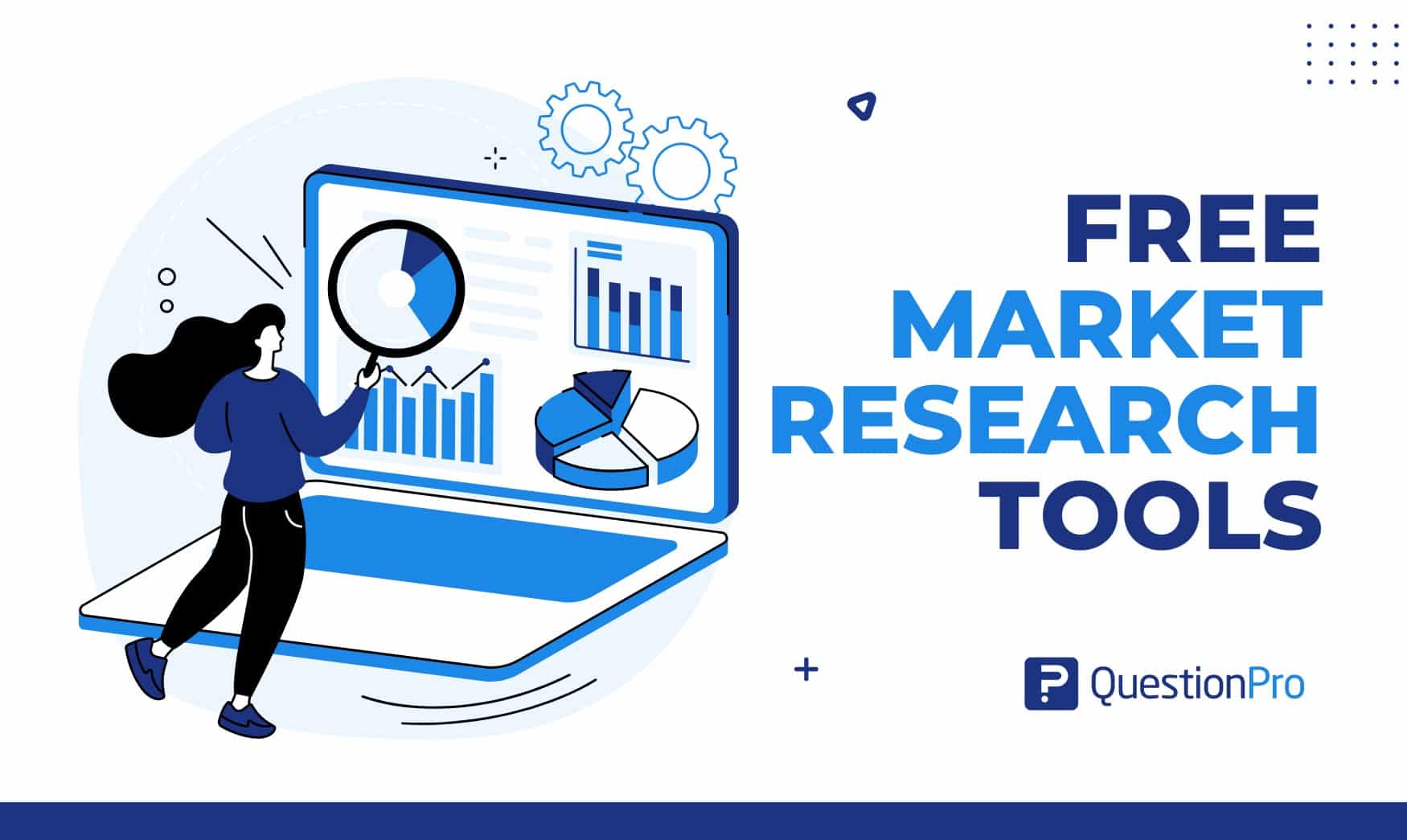
Top 10 Free Market Research Tools to Boost Your Business
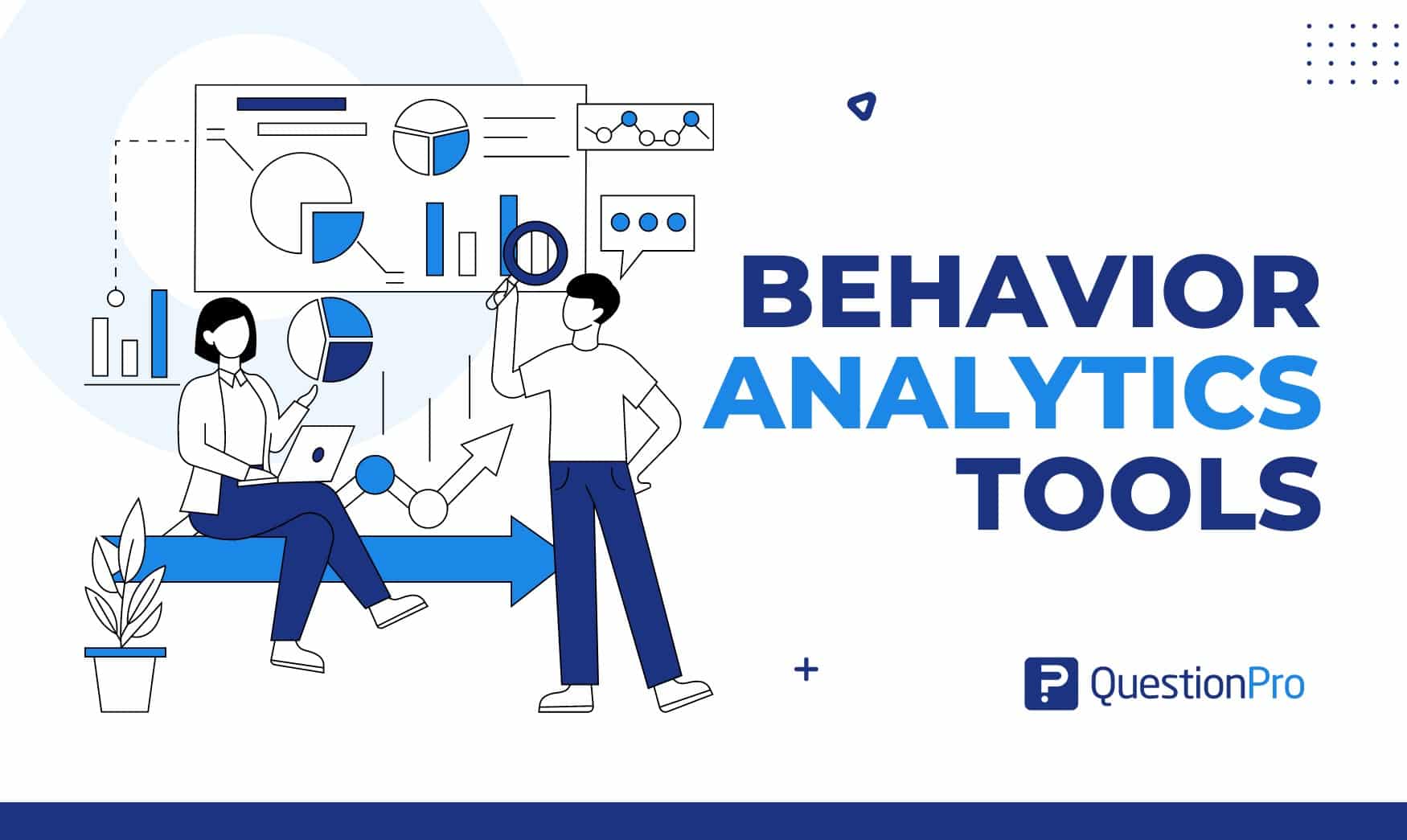
Best 15 Behavior Analytics Tools to Explore Your User Actions
Apr 8, 2024
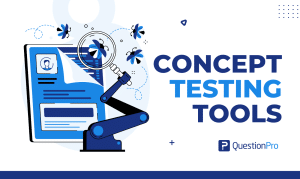
Top 7 Concept Testing Tools to Elevate Your Ideas in 2024
Other categories.
- Academic Research
- Artificial Intelligence
- Assessments
- Brand Awareness
- Case Studies
- Communities
- Consumer Insights
- Customer effort score
- Customer Engagement
- Customer Experience
- Customer Loyalty
- Customer Research
- Customer Satisfaction
- Employee Benefits
- Employee Engagement
- Employee Retention
- Friday Five
- General Data Protection Regulation
- Insights Hub
- Life@QuestionPro
- Market Research
- Mobile diaries
- Mobile Surveys
- New Features
- Online Communities
- Question Types
- Questionnaire
- QuestionPro Products
- Release Notes
- Research Tools and Apps
- Revenue at Risk
- Survey Templates
- Training Tips
- Uncategorized
- Video Learning Series
- What’s Coming Up
- Workforce Intelligence
- Privacy Policy
Buy Me a Coffee

Home » Conceptual Framework – Types, Methodology and Examples
Conceptual Framework – Types, Methodology and Examples
Table of Contents

Conceptual Framework
Definition:
A conceptual framework is a structured approach to organizing and understanding complex ideas, theories, or concepts. It provides a systematic and coherent way of thinking about a problem or topic, and helps to guide research or analysis in a particular field.
A conceptual framework typically includes a set of assumptions, concepts, and propositions that form a theoretical framework for understanding a particular phenomenon. It can be used to develop hypotheses, guide empirical research, or provide a framework for evaluating and interpreting data.
Conceptual Framework in Research
In research, a conceptual framework is a theoretical structure that provides a framework for understanding a particular phenomenon or problem. It is a key component of any research project and helps to guide the research process from start to finish.
A conceptual framework provides a clear understanding of the variables, relationships, and assumptions that underpin a research study. It outlines the key concepts that the study is investigating and how they are related to each other. It also defines the scope of the study and sets out the research questions or hypotheses.
Types of Conceptual Framework
Types of Conceptual Framework are as follows:
Theoretical Framework
A theoretical framework is an overarching set of concepts, ideas, and assumptions that help to explain and interpret a phenomenon. It provides a theoretical perspective on the phenomenon being studied and helps researchers to identify the relationships between different concepts. For example, a theoretical framework for a study on the impact of social media on mental health might draw on theories of communication, social influence, and psychological well-being.
Conceptual Model
A conceptual model is a visual or written representation of a complex system or phenomenon. It helps to identify the main components of the system and the relationships between them. For example, a conceptual model for a study on the factors that influence employee turnover might include factors such as job satisfaction, salary, work-life balance, and job security, and the relationships between them.
Empirical Framework
An empirical framework is based on empirical data and helps to explain a particular phenomenon. It involves collecting data, analyzing it, and developing a framework to explain the results. For example, an empirical framework for a study on the impact of a new health intervention might involve collecting data on the intervention’s effectiveness, cost, and acceptability to patients.
Descriptive Framework
A descriptive framework is used to describe a particular phenomenon. It helps to identify the main characteristics of the phenomenon and to develop a vocabulary to describe it. For example, a descriptive framework for a study on different types of musical genres might include descriptions of the instruments used, the rhythms and beats, the vocal styles, and the cultural contexts of each genre.
Analytical Framework
An analytical framework is used to analyze a particular phenomenon. It involves breaking down the phenomenon into its constituent parts and analyzing them separately. This type of framework is often used in social science research. For example, an analytical framework for a study on the impact of race on police brutality might involve analyzing the historical and cultural factors that contribute to racial bias, the organizational factors that influence police behavior, and the psychological factors that influence individual officers’ behavior.
Conceptual Framework for Policy Analysis
A conceptual framework for policy analysis is used to guide the development of policies or programs. It helps policymakers to identify the key issues and to develop strategies to address them. For example, a conceptual framework for a policy analysis on climate change might involve identifying the key stakeholders, assessing their interests and concerns, and developing policy options to mitigate the impacts of climate change.
Logical Frameworks
Logical frameworks are used to plan and evaluate projects and programs. They provide a structured approach to identifying project goals, objectives, and outcomes, and help to ensure that all stakeholders are aligned and working towards the same objectives.
Conceptual Frameworks for Program Evaluation
These frameworks are used to evaluate the effectiveness of programs or interventions. They provide a structure for identifying program goals, objectives, and outcomes, and help to measure the impact of the program on its intended beneficiaries.
Conceptual Frameworks for Organizational Analysis
These frameworks are used to analyze and evaluate organizational structures, processes, and performance. They provide a structured approach to understanding the relationships between different departments, functions, and stakeholders within an organization.
Conceptual Frameworks for Strategic Planning
These frameworks are used to develop and implement strategic plans for organizations or businesses. They help to identify the key factors and stakeholders that will impact the success of the plan, and provide a structure for setting goals, developing strategies, and monitoring progress.
Components of Conceptual Framework
The components of a conceptual framework typically include:
- Research question or problem statement : This component defines the problem or question that the conceptual framework seeks to address. It sets the stage for the development of the framework and guides the selection of the relevant concepts and constructs.
- Concepts : These are the general ideas, principles, or categories that are used to describe and explain the phenomenon or problem under investigation. Concepts provide the building blocks of the framework and help to establish a common language for discussing the issue.
- Constructs : Constructs are the specific variables or concepts that are used to operationalize the general concepts. They are measurable or observable and serve as indicators of the underlying concept.
- Propositions or hypotheses : These are statements that describe the relationships between the concepts or constructs in the framework. They provide a basis for testing the validity of the framework and for generating new insights or theories.
- Assumptions : These are the underlying beliefs or values that shape the framework. They may be explicit or implicit and may influence the selection and interpretation of the concepts and constructs.
- Boundaries : These are the limits or scope of the framework. They define the focus of the investigation and help to clarify what is included and excluded from the analysis.
- Context : This component refers to the broader social, cultural, and historical factors that shape the phenomenon or problem under investigation. It helps to situate the framework within a larger theoretical or empirical context and to identify the relevant variables and factors that may affect the phenomenon.
- Relationships and connections: These are the connections and interrelationships between the different components of the conceptual framework. They describe how the concepts and constructs are linked and how they contribute to the overall understanding of the phenomenon or problem.
- Variables : These are the factors that are being measured or observed in the study. They are often operationalized as constructs and are used to test the propositions or hypotheses.
- Methodology : This component describes the research methods and techniques that will be used to collect and analyze data. It includes the sampling strategy, data collection methods, data analysis techniques, and ethical considerations.
- Literature review : This component provides an overview of the existing research and theories related to the phenomenon or problem under investigation. It helps to identify the gaps in the literature and to situate the framework within the broader theoretical and empirical context.
- Outcomes and implications: These are the expected outcomes or implications of the study. They describe the potential contributions of the study to the theoretical and empirical knowledge in the field and the practical implications for policy and practice.
Conceptual Framework Methodology
Conceptual Framework Methodology is a research method that is commonly used in academic and scientific research to develop a theoretical framework for a study. It is a systematic approach that helps researchers to organize their thoughts and ideas, identify the variables that are relevant to their study, and establish the relationships between these variables.
Here are the steps involved in the conceptual framework methodology:
Identify the Research Problem
The first step is to identify the research problem or question that the study aims to answer. This involves identifying the gaps in the existing literature and determining what specific issue the study aims to address.
Conduct a Literature Review
The second step involves conducting a thorough literature review to identify the existing theories, models, and frameworks that are relevant to the research question. This will help the researcher to identify the key concepts and variables that need to be considered in the study.
Define key Concepts and Variables
The next step is to define the key concepts and variables that are relevant to the study. This involves clearly defining the terms used in the study, and identifying the factors that will be measured or observed in the study.
Develop a Theoretical Framework
Once the key concepts and variables have been identified, the researcher can develop a theoretical framework. This involves establishing the relationships between the key concepts and variables, and creating a visual representation of these relationships.
Test the Framework
The final step is to test the theoretical framework using empirical data. This involves collecting and analyzing data to determine whether the relationships between the key concepts and variables that were identified in the framework are accurate and valid.
Examples of Conceptual Framework
Some realtime Examples of Conceptual Framework are as follows:
- In economics , the concept of supply and demand is a well-known conceptual framework. It provides a structure for understanding how prices are set in a market, based on the interplay of the quantity of goods supplied by producers and the quantity of goods demanded by consumers.
- In psychology , the cognitive-behavioral framework is a widely used conceptual framework for understanding mental health and illness. It emphasizes the role of thoughts and behaviors in shaping emotions and the importance of cognitive restructuring and behavior change in treatment.
- In sociology , the social determinants of health framework provides a way of understanding how social and economic factors such as income, education, and race influence health outcomes. This framework is widely used in public health research and policy.
- In environmental science , the ecosystem services framework is a way of understanding the benefits that humans derive from natural ecosystems, such as clean air and water, pollination, and carbon storage. This framework is used to guide conservation and land-use decisions.
- In education, the constructivist framework is a way of understanding how learners construct knowledge through active engagement with their environment. This framework is used to guide instructional design and teaching strategies.
Applications of Conceptual Framework
Some of the applications of Conceptual Frameworks are as follows:
- Research : Conceptual frameworks are used in research to guide the design, implementation, and interpretation of studies. Researchers use conceptual frameworks to develop hypotheses, identify research questions, and select appropriate methods for collecting and analyzing data.
- Policy: Conceptual frameworks are used in policy-making to guide the development of policies and programs. Policymakers use conceptual frameworks to identify key factors that influence a particular problem or issue, and to develop strategies for addressing them.
- Education : Conceptual frameworks are used in education to guide the design and implementation of instructional strategies and curriculum. Educators use conceptual frameworks to identify learning objectives, select appropriate teaching methods, and assess student learning.
- Management : Conceptual frameworks are used in management to guide decision-making and strategy development. Managers use conceptual frameworks to understand the internal and external factors that influence their organizations, and to develop strategies for achieving their goals.
- Evaluation : Conceptual frameworks are used in evaluation to guide the development of evaluation plans and to interpret evaluation results. Evaluators use conceptual frameworks to identify key outcomes, indicators, and measures, and to develop a logic model for their evaluation.
Purpose of Conceptual Framework
The purpose of a conceptual framework is to provide a theoretical foundation for understanding and analyzing complex phenomena. Conceptual frameworks help to:
- Guide research : Conceptual frameworks provide a framework for researchers to develop hypotheses, identify research questions, and select appropriate methods for collecting and analyzing data. By providing a theoretical foundation for research, conceptual frameworks help to ensure that research is rigorous, systematic, and valid.
- Provide clarity: Conceptual frameworks help to provide clarity and structure to complex phenomena by identifying key concepts, relationships, and processes. By providing a clear and systematic understanding of a phenomenon, conceptual frameworks help to ensure that researchers, policymakers, and practitioners are all on the same page when it comes to understanding the issue at hand.
- Inform decision-making : Conceptual frameworks can be used to inform decision-making and strategy development by identifying key factors that influence a particular problem or issue. By understanding the complex interplay of factors that contribute to a particular issue, decision-makers can develop more effective strategies for addressing the problem.
- Facilitate communication : Conceptual frameworks provide a common language and conceptual framework for researchers, policymakers, and practitioners to communicate and collaborate on complex issues. By providing a shared understanding of a phenomenon, conceptual frameworks help to ensure that everyone is working towards the same goal.
When to use Conceptual Framework
There are several situations when it is appropriate to use a conceptual framework:
- To guide the research : A conceptual framework can be used to guide the research process by providing a clear roadmap for the research project. It can help researchers identify key variables and relationships, and develop hypotheses or research questions.
- To clarify concepts : A conceptual framework can be used to clarify and define key concepts and terms used in a research project. It can help ensure that all researchers are using the same language and have a shared understanding of the concepts being studied.
- To provide a theoretical basis: A conceptual framework can provide a theoretical basis for a research project by linking it to existing theories or conceptual models. This can help researchers build on previous research and contribute to the development of a field.
- To identify gaps in knowledge : A conceptual framework can help identify gaps in existing knowledge by highlighting areas that require further research or investigation.
- To communicate findings : A conceptual framework can be used to communicate research findings by providing a clear and concise summary of the key variables, relationships, and assumptions that underpin the research project.
Characteristics of Conceptual Framework
key characteristics of a conceptual framework are:
- Clear definition of key concepts : A conceptual framework should clearly define the key concepts and terms being used in a research project. This ensures that all researchers have a shared understanding of the concepts being studied.
- Identification of key variables: A conceptual framework should identify the key variables that are being studied and how they are related to each other. This helps to organize the research project and provides a clear focus for the study.
- Logical structure: A conceptual framework should have a logical structure that connects the key concepts and variables being studied. This helps to ensure that the research project is coherent and consistent.
- Based on existing theory : A conceptual framework should be based on existing theory or conceptual models. This helps to ensure that the research project is grounded in existing knowledge and builds on previous research.
- Testable hypotheses or research questions: A conceptual framework should include testable hypotheses or research questions that can be answered through empirical research. This helps to ensure that the research project is rigorous and scientifically valid.
- Flexibility : A conceptual framework should be flexible enough to allow for modifications as new information is gathered during the research process. This helps to ensure that the research project is responsive to new findings and is able to adapt to changing circumstances.
Advantages of Conceptual Framework
Advantages of the Conceptual Framework are as follows:
- Clarity : A conceptual framework provides clarity to researchers by outlining the key concepts and variables that are relevant to the research project. This clarity helps researchers to focus on the most important aspects of the research problem and develop a clear plan for investigating it.
- Direction : A conceptual framework provides direction to researchers by helping them to develop hypotheses or research questions that are grounded in existing theory or conceptual models. This direction ensures that the research project is relevant and contributes to the development of the field.
- Efficiency : A conceptual framework can increase efficiency in the research process by providing a structure for organizing ideas and data. This structure can help researchers to avoid redundancies and inconsistencies in their work, saving time and effort.
- Rigor : A conceptual framework can help to ensure the rigor of a research project by providing a theoretical basis for the investigation. This rigor is essential for ensuring that the research project is scientifically valid and produces meaningful results.
- Communication : A conceptual framework can facilitate communication between researchers by providing a shared language and understanding of the key concepts and variables being studied. This communication is essential for collaboration and the advancement of knowledge in the field.
- Generalization : A conceptual framework can help to generalize research findings beyond the specific study by providing a theoretical basis for the investigation. This generalization is essential for the development of knowledge in the field and for informing future research.
Limitations of Conceptual Framework
Limitations of Conceptual Framework are as follows:
- Limited applicability: Conceptual frameworks are often based on existing theory or conceptual models, which may not be applicable to all research problems or contexts. This can limit the usefulness of a conceptual framework in certain situations.
- Lack of empirical support : While a conceptual framework can provide a theoretical basis for a research project, it may not be supported by empirical evidence. This can limit the usefulness of a conceptual framework in guiding empirical research.
- Narrow focus: A conceptual framework can provide a clear focus for a research project, but it may also limit the scope of the investigation. This can make it difficult to address broader research questions or to consider alternative perspectives.
- Over-simplification: A conceptual framework can help to organize and structure research ideas, but it may also over-simplify complex phenomena. This can limit the depth of the investigation and the richness of the data collected.
- Inflexibility : A conceptual framework can provide a structure for organizing research ideas, but it may also be inflexible in the face of new data or unexpected findings. This can limit the ability of researchers to adapt their research project to new information or changing circumstances.
- Difficulty in development : Developing a conceptual framework can be a challenging and time-consuming process. It requires a thorough understanding of existing theory or conceptual models, and may require collaboration with other researchers.
About the author
Muhammad Hassan
Researcher, Academic Writer, Web developer
You may also like

Data Collection – Methods Types and Examples

Delimitations in Research – Types, Examples and...

Research Process – Steps, Examples and Tips

Research Design – Types, Methods and Examples

Institutional Review Board – Application Sample...

Evaluating Research – Process, Examples and...
How To Make Conceptual Framework (With Examples and Templates)
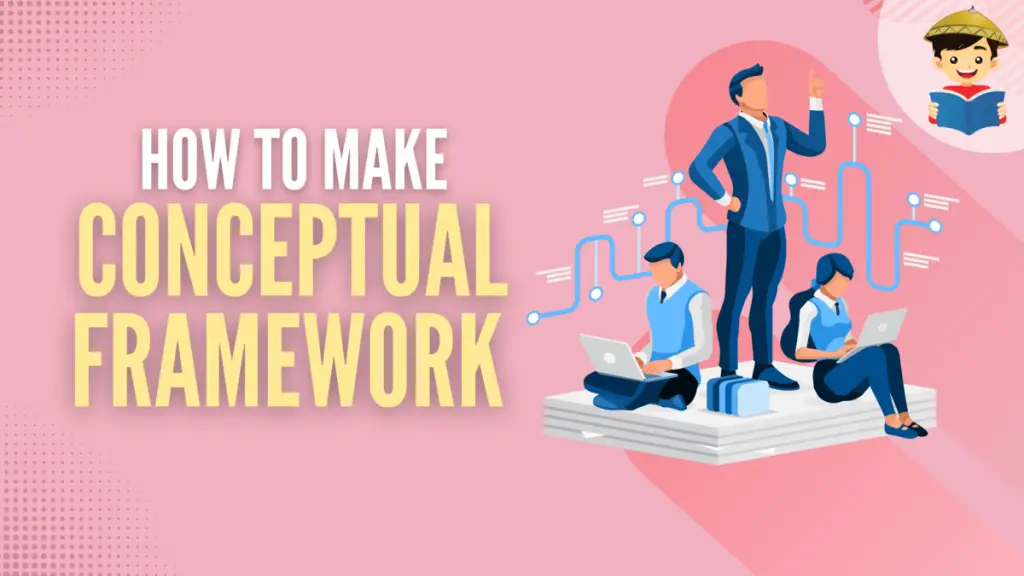
We all know that a research paper has plenty of concepts involved. However, a great deal of concepts makes your study confusing.
A conceptual framework ensures that the concepts of your study are organized and presented comprehensively. Let this article guide you on how to make the conceptual framework of your study.
Related: How to Write a Concept Paper for Academic Research
Table of Contents
At a glance: free conceptual framework templates.
Too busy to create a conceptual framework from scratch? No problem. We’ve created templates for each conceptual framework so you can start on the right foot. All you need to do is enter the details of the variables. Feel free to modify the design according to your needs. Please read the main article below to learn more about the conceptual framework.
Conceptual Framework Template #1: Independent-Dependent Variable Model
Conceptual framework template #2: input-process-output (ipo) model, conceptual framework template #3: concept map, what is a conceptual framework.
A conceptual framework shows the relationship between the variables of your study. It includes a visual diagram or a model that summarizes the concepts of your study and a narrative explanation of the model presented.
Why Should Research Be Given a Conceptual Framework?
Imagine your study as a long journey with the research result as the destination. You don’t want to get lost in your journey because of the complicated concepts. This is why you need to have a guide. The conceptual framework keeps you on track by presenting and simplifying the relationship between the variables. This is usually done through the use of illustrations that are supported by a written interpretation.
Also, people who will read your research must have a clear guide to the variables in your study and where the research is heading. By looking at the conceptual framework, the readers can get the gist of the research concepts without reading the entire study.
Related: How to Write Significance of the Study (with Examples)
What Is the Difference Between Conceptual Framework and Theoretical Framework?
Both of them show concepts and ideas of your study. The theoretical framework presents the theories, rules, and principles that serve as the basis of the research. Thus, the theoretical framework presents broad concepts related to your study. On the other hand, the conceptual framework shows a specific approach derived from the theoretical framework. It provides particular variables and shows how these variables are related.
Let’s say your research is about the Effects of Social Media on the Political Literacy of College Students. You may include some theories related to political literacy, such as this paper, in your theoretical framework. Based on this paper, political participation and awareness determine political literacy.
For the conceptual framework, you may state that the specific form of political participation and awareness you will use for the study is the engagement of college students on political issues on social media. Then, through a diagram and narrative explanation, you can show that using social media affects the political literacy of college students.
What Are the Different Types of Conceptual Frameworks?
The conceptual framework has different types based on how the research concepts are organized 1 .
1. Taxonomy
In this type of conceptual framework, the phenomena of your study are grouped into categories without presenting the relationship among them. The point of this conceptual framework is to distinguish the categories from one another.
2. Visual Presentation
In this conceptual framework, the relationship between the phenomena and variables of your study is presented. Using this conceptual framework implies that your research provides empirical evidence to prove the relationship between variables. This is the type of conceptual framework that is usually used in research studies.
3. Mathematical Description
In this conceptual framework, the relationship between phenomena and variables of your study is described using mathematical formulas. Also, the extent of the relationship between these variables is presented with specific quantities.
How To Make Conceptual Framework: 4 Steps
1. identify the important variables of your study.
There are two essential variables that you must identify in your study: the independent and the dependent variables.
An independent variable is a variable that you can manipulate. It can affect the dependent variable. Meanwhile, the dependent variable is the resulting variable that you are measuring.
You may refer to your research question to determine your research’s independent and dependent variables.
Suppose your research question is: “Is There a Significant Relationship Between the Quantity of Organic Fertilizer Used and the Plant’s Growth Rate?” The independent variable of this study is the quantity of organic fertilizer used, while the dependent variable is the plant’s growth rate.
2. Think About How the Variables Are Related
Usually, the variables of a study have a direct relationship. If a change in one of your variables leads to a corresponding change in another, they might have this kind of relationship.
However, note that having a direct relationship between variables does not mean they already have a cause-and-effect relationship 2 . It takes statistical analysis to prove causation between variables.
Using our example earlier, the quantity of organic fertilizer may directly relate to the plant’s growth rate. However, we are not sure that the quantity of organic fertilizer is the sole reason for the plant’s growth rate changes.
3. Analyze and Determine Other Influencing Variables
Consider analyzing if other variables can affect the relationship between your independent and dependent variables 3 .
4. Create a Visual Diagram or a Model
Now that you’ve identified the variables and their relationship, you may create a visual diagram summarizing them.
Usually, shapes such as rectangles, circles, and arrows are used for the model. You may create a visual diagram or model for your conceptual framework in different ways. The three most common models are the independent-dependent variable model, the input-process-output (IPO) model, and concept maps.
a. Using the Independent-Dependent Variable Model
You may create this model by writing the independent and dependent variables inside rectangles. Then, insert a line segment between them, connecting the rectangles. This line segment indicates the direct relationship between these variables.
Below is a visual diagram based on our example about the relationship between organic fertilizer and a plant’s growth rate.

b. Using the Input-Process-Output (IPO) Model
If you want to emphasize your research process, the input-process-output model is the appropriate visual diagram for your conceptual framework.
To create your visual diagram using the IPO model, follow these steps:
- Determine the inputs of your study . Inputs are the variables you will use to arrive at your research result. Usually, your independent variables are also the inputs of your research. Let’s say your research is about the Level of Satisfaction of College Students Using Google Classroom as an Online Learning Platform. You may include in your inputs the profile of your respondents and the curriculum used in the online learning platform.
- Outline your research process. Using our example above, the research process should be like this: Data collection of student profiles → Administering questionnaires → Tabulation of students’ responses → Statistical data analysis.
- State the research output . Indicate what you are expecting after you conduct the research. In our example above, the research output is the assessed level of satisfaction of college students with the use of Google Classroom as an online learning platform.
- Create the model using the research’s determined input, process, and output.
Presented below is the IPO model for our example above.

c. Using Concept Maps
If you think the two models presented previously are insufficient to summarize your study’s concepts, you may use a concept map for your visual diagram.
A concept map is a helpful visual diagram if multiple variables affect one another. Let’s say your research is about Coping with the Remote Learning System: Anxiety Levels of College Students. Presented below is the concept map for the research’s conceptual framework:
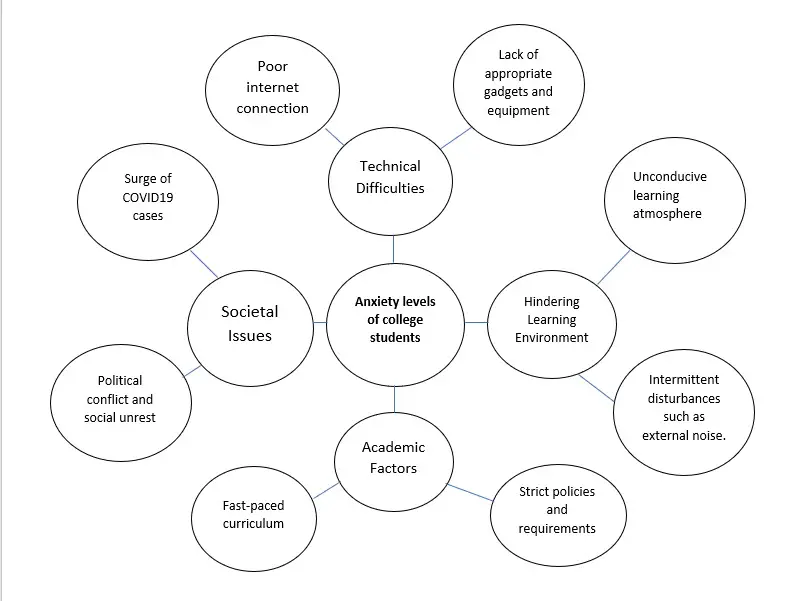
5. Explain Your Conceptual Framework in Narrative Form
Provide a brief explanation of your conceptual framework. State the essential variables, their relationship, and the research outcome.
Using the same example about the relationship between organic fertilizer and the growth rate of the plant, we can come up with the following explanation to accompany the conceptual framework:
Figure 1 shows the Conceptual Framework of the study. The quantity of the organic fertilizer used is the independent variable, while the plant’s growth is the research’s dependent variable. These two variables are directly related based on the research’s empirical evidence.
Conceptual Framework in Quantitative Research
You can create your conceptual framework by following the steps discussed in the previous section. Note, however, that quantitative research has statistical analysis. Thus, you may use arrows to indicate a cause-and-effect relationship in your model. An arrow implies that your independent variable caused the changes in your dependent variable.
Usually, for quantitative research, the Input-Process-Output model is used as a visual diagram. Here is an example of a conceptual framework in quantitative research:
Research Topic : Level of Effectiveness of Corn (Zea mays) Silk Ethanol Extract as an Antioxidant

Conceptual Framework in Qualitative Research
Again, you can follow the same step-by-step guide discussed previously to create a conceptual framework for qualitative research. However, note that you should avoid using one-way arrows as they may indicate causation . Qualitative research cannot prove causation since it uses only descriptive and narrative analysis to relate variables.
Here is an example of a conceptual framework in qualitative research:
Research Topic : Lived Experiences of Medical Health Workers During Community Quarantine
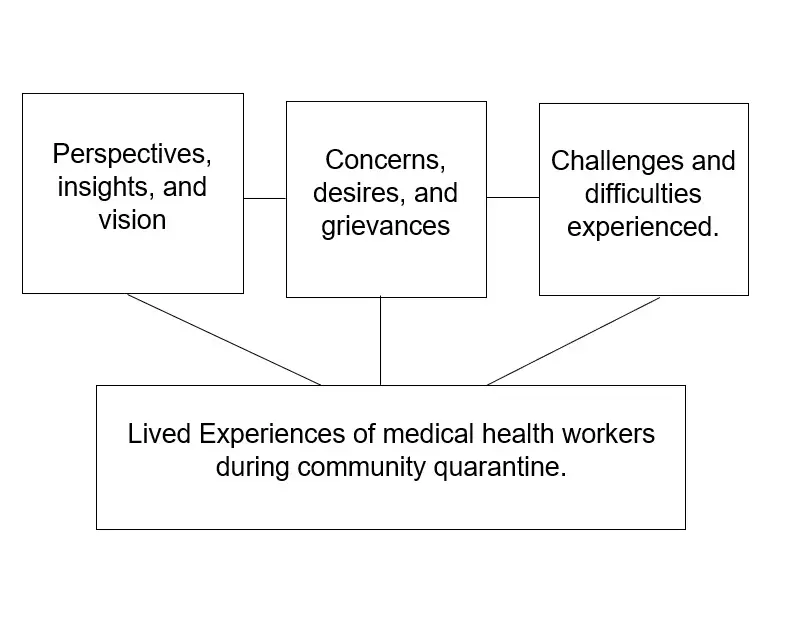
Conceptual Framework Examples
Presented below are some examples of conceptual frameworks.
Research Topic : Hypoglycemic Ability of Gabi (Colocasia esculenta) Leaf Extract in the Blood Glucose Level of Swiss Mice (Mus musculus)

Figure 1 presents the Conceptual Framework of the study. The quantity of gabi leaf extract is the independent variable, while the Swiss mice’s blood glucose level is the study’s dependent variable. This study establishes a direct relationship between these variables through empirical evidence and statistical analysis .
Research Topic : Level of Effectiveness of Using Social Media in the Political Literacy of College Students

Figure 1 shows the Conceptual Framework of the study. The input is the profile of the college students according to sex, year level, and the social media platform being used. The research process includes administering the questionnaires, tabulating students’ responses, and statistical data analysis and interpretation. The output is the effectiveness of using social media in the political literacy of college students.
Research Topic: Factors Affecting the Satisfaction Level of Community Inhabitants
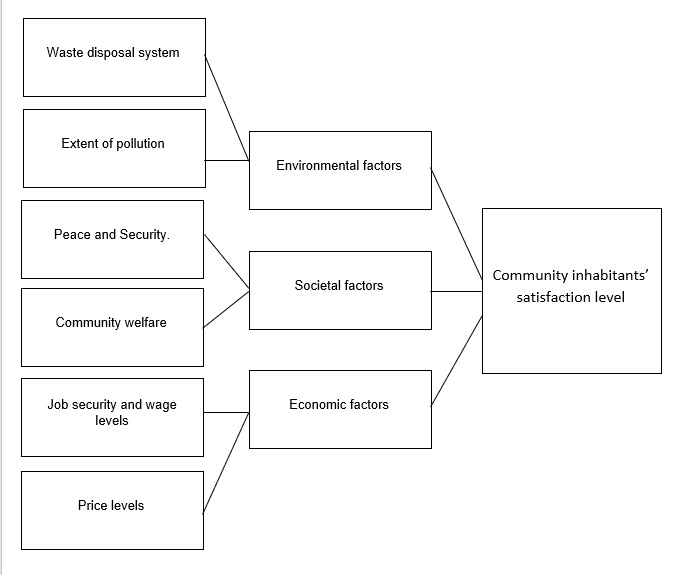
Figure 1 presents a visual illustration of the factors that affect the satisfaction level of community inhabitants. As presented, environmental, societal, and economic factors influence the satisfaction level of community inhabitants. Each factor has its indicators which are considered in this study.
Tips and Warnings
- Please keep it simple. Avoid using fancy illustrations or designs when creating your conceptual framework.
- Allot a lot of space for feedback. This is to show that your research variables or methodology might be revised based on the input from the research panel. Below is an example of a conceptual framework with a spot allotted for feedback.

Frequently Asked Questions
1. how can i create a conceptual framework in microsoft word.
First, click the Insert tab and select Shapes . You’ll see a wide range of shapes to choose from. Usually, rectangles, circles, and arrows are the shapes used for the conceptual framework.

Next, draw your selected shape in the document.
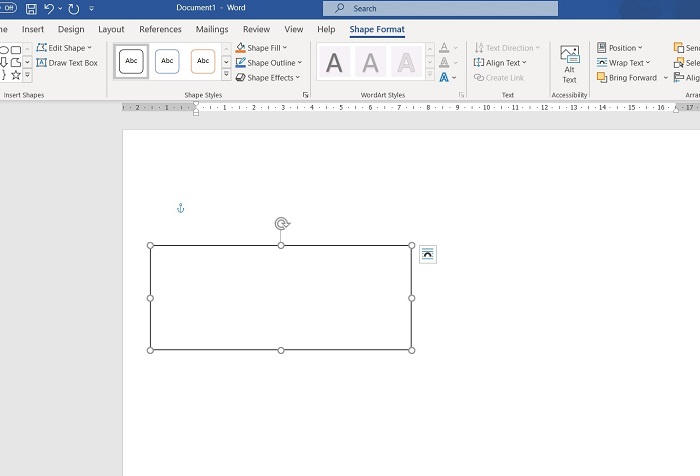
Insert the name of the variable inside the shape. You can do this by pointing your cursor to the shape, right-clicking your mouse, selecting Add Text , and typing in the text.
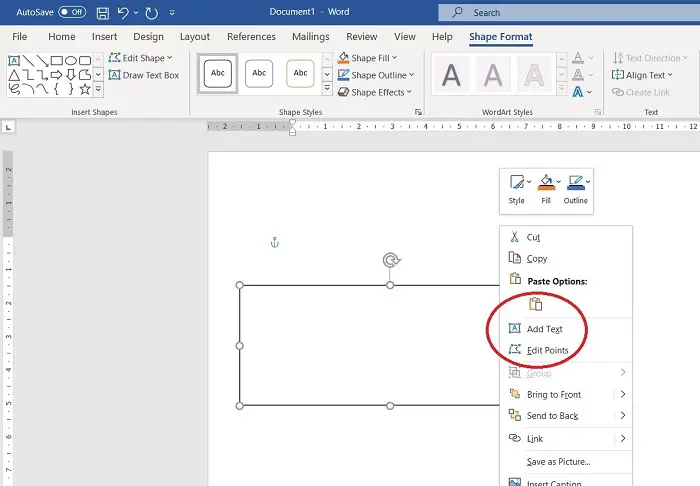
Repeat the same process for the remaining variables of your study. If you need arrows to connect the different variables, you can insert one by going to the Insert tab, then Shape, and finally, Lines or Block Arrows, depending on your preferred arrow style.
2. How to explain my conceptual framework in defense?
If you have used the Independent-Dependent Variable Model in creating your conceptual framework, start by telling your research’s variables. Afterward, explain the relationship between these variables. Example: “Using statistical/descriptive analysis of the data we have collected, we are going to show how the <state your independent variable> exhibits a significant relationship to <state your dependent variable>.”
On the other hand, if you have used an Input-Process-Output Model, start by explaining the inputs of your research. Then, tell them about your research process. You may refer to the Research Methodology in Chapter 3 to accurately present your research process. Lastly, explain what your research outcome is.
Meanwhile, if you have used a concept map, ensure you understand the idea behind the illustration. Discuss how the concepts are related and highlight the research outcome.
3. In what stage of research is the conceptual framework written?
The research study’s conceptual framework is in Chapter 2, following the Review of Related Literature.
4. What is the difference between a Conceptual Framework and Literature Review?
The Conceptual Framework is a summary of the concepts of your study where the relationship of the variables is presented. On the other hand, Literature Review is a collection of published studies and literature related to your study.
Suppose your research concerns the Hypoglycemic Ability of Gabi (Colocasia esculenta) Leaf Extract on Swiss Mice (Mus musculus). In your conceptual framework, you will create a visual diagram and a narrative explanation presenting the quantity of gabi leaf extract and the mice’s blood glucose level as your research variables. On the other hand, for the literature review, you may include this study and explain how this is related to your research topic.
5. When do I use a two-way arrow for my conceptual framework?
You will use a two-way arrow in your conceptual framework if the variables of your study are interdependent. If variable A affects variable B and variable B also affects variable A, you may use a two-way arrow to show that A and B affect each other.
Suppose your research concerns the Relationship Between Students’ Satisfaction Levels and Online Learning Platforms. Since students’ satisfaction level determines the online learning platform the school uses and vice versa, these variables have a direct relationship. Thus, you may use two-way arrows to indicate that the variables directly affect each other.
- Conceptual Framework – Meaning, Importance and How to Write it. (2020). Retrieved 27 April 2021, from https://afribary.com/knowledge/conceptual-framework/
- Correlation vs Causation. Retrieved 27 April 2021, from https://www.jmp.com/en_ph/statistics-knowledge-portal/what-is-correlation/correlation-vs-causation.html
- Swaen, B., & George, T. (2022, August 22). What is a conceptual framework? Tips & Examples. Retrieved December 5, 2022, from https://www.scribbr.com/methodology/conceptual-framework/
Written by Jewel Kyle Fabula
in Career and Education , Juander How
Last Updated May 6, 2023 10:37 AM
Jewel Kyle Fabula
Jewel Kyle Fabula is a Bachelor of Science in Economics student at the University of the Philippines Diliman. His passion for learning mathematics developed as he competed in some mathematics competitions during his Junior High School years. He loves cats, playing video games, and listening to music.
Browse all articles written by Jewel Kyle Fabula
Copyright Notice
All materials contained on this site are protected by the Republic of the Philippines copyright law and may not be reproduced, distributed, transmitted, displayed, published, or broadcast without the prior written permission of filipiknow.net or in the case of third party materials, the owner of that content. You may not alter or remove any trademark, copyright, or other notice from copies of the content. Be warned that we have already reported and helped terminate several websites and YouTube channels for blatantly stealing our content. If you wish to use filipiknow.net content for commercial purposes, such as for content syndication, etc., please contact us at legal(at)filipiknow(dot)net

- Vehicle Technologies Office
- About the Vehicle Technologies Office
- Technology Areas
- Technology Integration
- Reports and Publications
Office: Vehicle Technologies Office FOA number: DE-FOA-0003248 Link to apply: Apply on EERE Exchange FOA Amount: $45,800,000
Today, the Department of Energy (DOE) announced $45.8 million in new funding for projects that will advance research, development, demonstration, and deployment (RDD&D) critical to achieving net-zero greenhouse gas emissions in the transportation sector. The funding will drive innovation in equitable clean transportation and is aligned with strategies detailed in the U.S. National Blueprint for Transportation Decarbonization .
The funding is through DOE’s Office of Energy Efficiency and Renewable Energy (EERE). Topic areas in the Vehicle Technologies Office (VTO) Fiscal Year (FY) 2024 R&D funding opportunity include:
- Next-generation phosphate-based cathodes.
- Advancing the state of the art for sodium-ion batteries.
- Developing concepts for decreasing greenhouse gas emissions from off-road vehicles such as construction, agriculture, mining, and forestry vehicles.
- Developing and deploying vehicle-to-everything technologies that can lead to meaningful savings at the vehicle and transportation system level.
- Developing high-performance, domestically produced electrical steels (E-steels) for use in electrified powertrains.
- Addressing critical cybersecurity needs for smart and secure electric vehicle charging.
As part of the Biden-Harris Administration’s commitment to ensuring the benefits of a clean transportation system are shared equally, the funding seeks the participation of underserved communities and underrepresented groups. Applicants are required to describe how diversity, equity, and inclusion objectives will be incorporated into their project.
VTO provides a series of funding opportunity announcement (FOA) information session videos , which help applicants understand VTO’s FOA process and requirements. The recently released, Session 3: Tips for a Strong FOA Application, includes best practices for incorporating Diversity, Equity, Inclusion, and Accessibility in a project.
Learn more about this and other funding opportunities on VTO’s funding webpage .
Topic Areas
Topic Area 1: Next-Generation Phosphate-Based Cathodes
This topic area targets the development of phosphate-based cathode materials that surpass the performance of state-of-the-art lithium iron phosphate (LFP) cathode materials, which are currently gaining traction as an alternative low-cost solution. The primary objective of this area of interest is to develop high energy density battery cells containing phosphate-based cathodes at the material and cell level.
Topic Area 2: Na-ion Battery Seedling Projects for Electric Vehicle Applications
While shifting to alternative cathode materials like LFP can alleviate the impact of nickel and cobalt, the impact of lithium has not been adequately addressed. One alternative to lithium is sodium (Na). While there is much promise for Na-ion chemistries, key issues still limit their adoption. This objective of this topic area is to advance the state of the art for Na-ion batteries by solving key challenges for the cathode, anode, or electrolyte through the development of 1 Ah full cells utilizing cell chemistries that are significant advancements over current industry state-of-the-art Na-ion technology.
Topic Area 3: Low-GHG Concepts for Off-Road Vehicles
The objective of this topic area is to develop and validate technology concepts capable of significantly decreasing greenhouse gas emissions, energy use, harmful criteria emissions, and total cost of ownership across the entire off-road vehicle sector, including construction, agriculture, mining, forestry, ports, warehouses, etc. Concepts must demonstrate they can meet the unique requirements for off-road vehicles and gain customer acceptance.
Topic Area 4: Saving Energy with Connectivity
Research has shown that vehicle-to-everything (V2X) communications can lead to meaningful energy savings at the vehicle and transportation system level by integrating interoperable vehicle-to-vehicle (V2V), vehicle-to-infrastructure (V2I), and vehicle-to-pedestrian (V2P) communications. The objective of this topic area is to develop and deploy V2X technologies with a focus on the efficiency and convenience of the mobility ecosystem, while reducing transportation’s environmental impacts. Examples could include but are not limited to eco-driving along connected corridors, transit or freight priority, integrated corridor management, or passenger or freight trip-chaining optimization.
Topic Area 5: Domestically Produced Electrical Steels (E-Steels)
The US transportation sector is in a technology revolution where light-duty vehicles are rapidly transitioning from internal combustion engines to electrified powertrains. Although most of the vehicles are produced in the US, many of the powertrain components rely on imports and foreign supply chains. Of particular interest are traction motors and their components. The objective of this topic are is to develop E-Steels meeting properties including frequency, thickness, ductility, cost, and manufacturability.
Topic Area 6: Cybersecurity for Smart and Secure Electric Vehicle Charging
This topic area is addressing critical cybersecurity needs to address through two subtopics:
- Subtopic 6.a: Enabling Wide-scale, Cybersecure EV/EVSE Aggregation for Grid Services : To support the integration of electric vehicles (EVs) and their charging requirements with the electric grid, both government and the private sector have made significant investments in the development of smart charge management (SCM) systems and technologies for EV charging infrastructure. The objective of this subtopic area is to research, develop, and demonstrate systems, technologies, and tools necessary for the cybersecure aggregation of EVs and charging infrastructure to provide widescale, cybersecure grid services.
- Subtopic 6.b: Tools to Assess EV/EVSE/Charging System Cybersecurity Posture and Compliance with Standards and Protocols for Communications, Controls, and Monitoring : Testing and evaluation of Electric Vehicle Supply Equipment (EVSE) by DOE national laboratories has clearly indicated a lack of compliance by many vendors with certified and/or regulated EV charging standards and protocols. In addition to creating cybersecurity vulnerabilities, this non-compliance greatly inhibits interoperability, supplier-managed SCM, and right-to-repair. The objective of this subtopic is to research, develop, and validate a suite of tools and associated procedures to comprehensively assess EV/EVSE/charging system compliance with relevant standards and protocols and cybersecurity posture.
Additional Information
- Download the full funding opportunity on the EERE Exchange website.
- For FOA-specific support, contact [email protected] .
- Sign up for the Office of Energy Efficiency and Renewable Energy (EERE) funding email list to get notified of new EERE funding opportunities. Also sign up for VTO’s newsletter to stay current with the latest news.
- Watch the VTO Funding Opportunity Announcement information series webinars.

IMAGES
VIDEO
COMMENTS
A good conceptual paper may also build theory by offering propositions regarding previously untested relationships. Unlike, a purely theoretical paper, the propositions in a conceptual paper should be more closely linked to testable hypotheses and in doing so offer a bridge between validation and usefulness (Weick, 1989). The Mael and Jex paper ...
Abstract and Figures. This handout provides a detailed outline of how to write a conceptual academic paper for scholarly journal publication. It is based on my academic publishing experience and ...
A concept paper primarily focuses on introducing the basic idea, intended research question, and the framework that will guide the research. Purpose of a Concept Paper. A concept paper serves as an initial document, commonly required by private organizations before a formal proposal submission.
The conceptual article can make a valuable contribution to the scholarly conversation but presents its own special challenges compared to the traditional article that reports empirical findings or interpretive analysis with a familiar organizational structure. ... In many research papers the job of tying the previous literature to the problem ...
This paper addresses issues of methodology and research design for conceptual papers. The discussion is built on previous "how to" guides to conceptual research, and on examples from high quality journals to identify and illustrate different options for conceptual research design. This paper discusses four templates—Theory Synthesis ...
A concept paper is a short document written by a researcher before starting their research project, with the purpose of explaining what the study is about, why it is important and the methods that will be used. The concept paper will include your proposed research title, a brief introduction to the subject, the aim of the study, the research ...
Writing the Conceptual Article: A Practical Guide. Stephen D. Reese. University of Texas, Austin, Texas, USA. ABSTRACT. The conceptual articl e can make a valuable contr ibution to the. scholarly ...
conceptual research. Conceptual papers: some methodological requirements The term "research design" refers to decisions about how to achieve research goals, linking theories, questions, and goals to appropriate resources and methods (Flick2018, p. 102). In short, the research design is a plan for
1. To explore and expand an idea: Researchers can use concept papers to transform an incipient research idea into a focused, high-quality study proposal. The paper is also a means to obtain feedback that can be used to strengthen a detailed proposal at a later stage. 2. To draw the interest of funding agencies: Through an effective concept ...
The aim of this paper is to highlight methodological considerations for conceptual papers: it is argued that such papers must be grounded in a clear research design, and that the choice of ...
Conceptual review papers can theoretically enrich the field of marketing by reviewing extant knowledge, noting tensions and inconsistencies, identifying important gaps as well as key insights, and proposing agendas for future research. The result of this process is a theoretical contribution that refines, reconceptualizes, or even replaces existing ways of viewing a phenomenon. This paper ...
Developing a conceptual framework in research. Step 1: Choose your research question. Step 2: Select your independent and dependent variables. Step 3: Visualize your cause-and-effect relationship. Step 4: Identify other influencing variables. Frequently asked questions about conceptual models.
It's research based on pen and paper. 2. This type of research heavily relies on previously conducted studies; no form of experiment is conducted, which saves time, effort, and resources. More relevant information can be generated by conducting conceptual research. 3.
The Research Concept Paper is completed prior to the dissertation proposal and serves as a development tool and summary of the planned dissertation. The Concept paper is a brief document. Depending upon the requirements of the specific school or academic program, the Concept Paper may range from as few as 2-3 pages to as many as 10-20 pages.
to interest potential funders. to develop potential solutions or investigations into project ideas. to determine whether a project idea is fundable. to serve as the foundation of a full proposal. Funders that request concept papers often provide a template or format. If templates or formats are not provided, the following can serve as a useful ...
Research grant concept papers. Concept Paper vs. Research Proposal. Getting Started on Your Concept Paper. 1. Find a research topic you are interested in. Tips for finding your research topic. 2. Think of research questions that you want to answer in your project. 3.
Therefore, in order to write a simple concept paper, follow these steps: 1. Concept paper title. Every pa per must have a title and concept paper is not left out as one needs to have a title that ...
A conceptual framework is a structured approach to organizing and understanding complex ideas, theories, or concepts. It provides a systematic and coherent way of thinking about a problem or topic, and helps to guide research or analysis in a particular field. A conceptual framework typically includes a set of assumptions, concepts, and ...
Related: How to Write a Concept Paper for Academic Research Table of Contents. At a Glance: Free Conceptual Framework Templates. Conceptual Framework Template #1: Independent-Dependent Variable Model ... Presented below is the concept map for the research's conceptual framework: 5. Explain Your Conceptual Framework in Narrative Form.
National Bureau of Economic Research
Conceptual papers provide new lenses for seeing familiar concepts, constructs, or theories differently. Conceptual papers focus on suggesting and integrating novel linkages between perspectives ...
This research proposes an extension to the Technology Acceptance Models by including trust as a predictor for acceptance and behavioral intention. To this end, a multidisciplinary scoping literature review was conducted to identify the determinants and metrics of trust and construct a model for semi-autonomous vehicles adoption.
Office: Vehicle Technologies Office FOA number: DE-FOA-0003248 Link to apply: Apply on EERE Exchange FOA Amount: $45,800,000 Today, the Department of Energy (DOE) announced $45.8 million in new funding for projects that will advance research, development, demonstration, and deployment (RDD&D) critical to achieving net-zero greenhouse gas emissions in the transportation sector.